Hi all, thanks for coming by! I’m excited to share with you my final learning summary video of EDTC300
Thanks again so much for engaging, visiting, and watching!
Colorfully yours,
Maya

Hi all, thanks for coming by! I’m excited to share with you my final learning summary video of EDTC300
Thanks again so much for engaging, visiting, and watching!
Colorfully yours,
Maya

This class has been such a wonderful experience. A part of it was the community that was built and the space in which we all had lots to contribute and learn.
In this post, I’ll share some of my engagement with classmates and how I was able to contribute to our shared learning environment, across varied platforms.
The way I see it, it’s like we have a huge canvas. And we each have a color to bring (or a few) to the palate.
Together, we have so many more hues to paint with and create a colorful landscape!
Commenting on blog posts
One great thing I appreciate about this course is the sense of community we created, amongst other ways, through our blogs. Reading, engaging, and learning with classmates with their blogs was a truly fun and great experience. I focused on engaging with at least 3 blogs per week and trying to explore new blogs of more classmates, follow up on classmates’ projects from week to week, and learn so much with them. The creativity in the learning projects, skills sets in weekly blogs, and more- was so great to engage with. Here are just some of them, from across the semester:

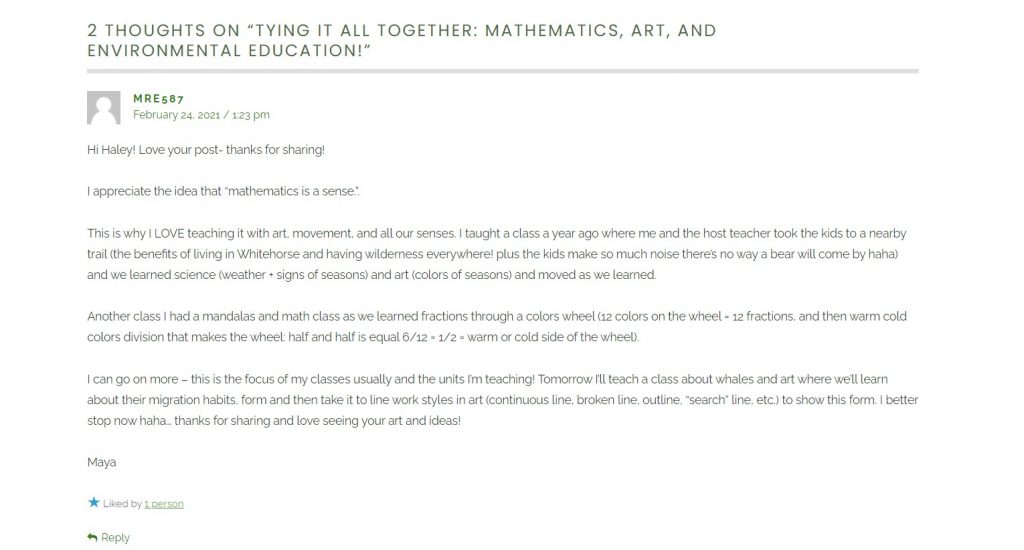
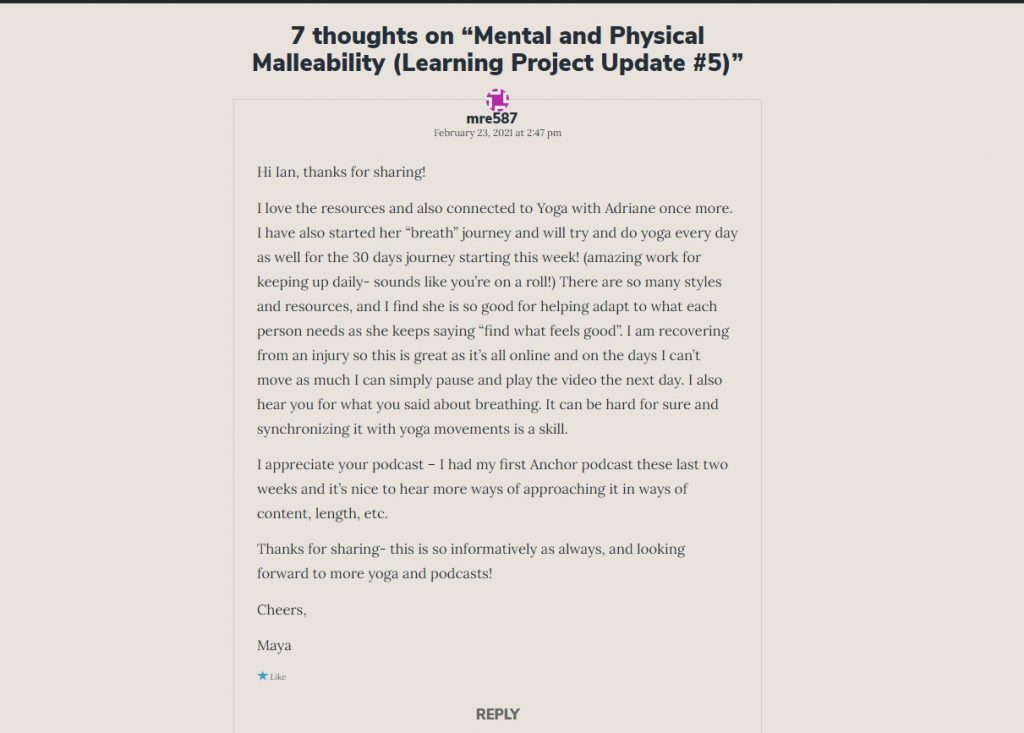
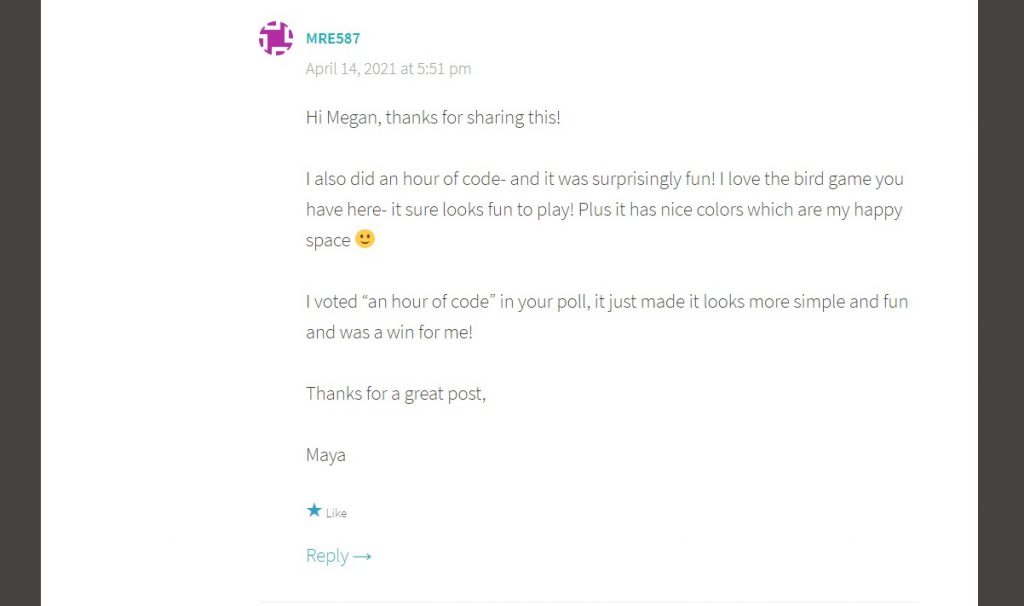
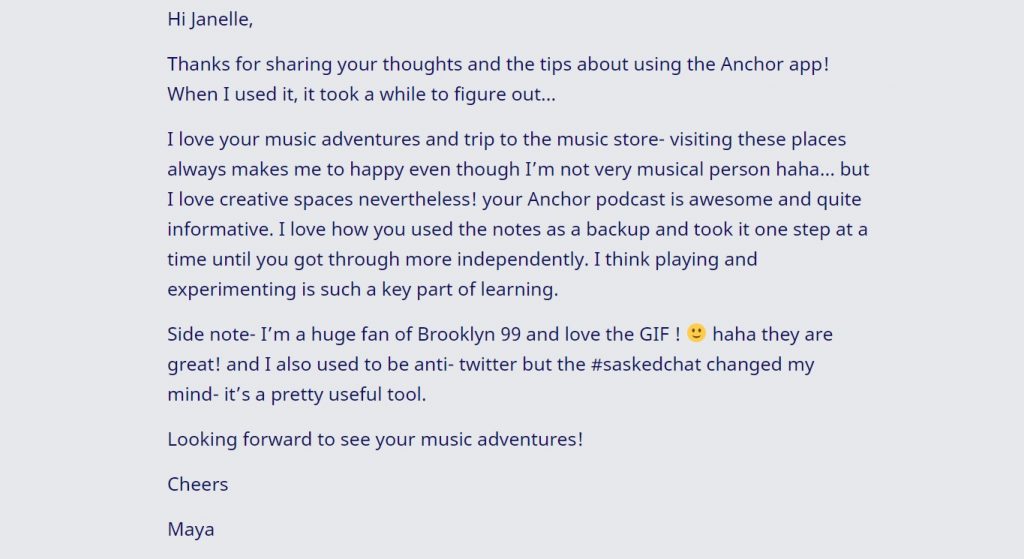
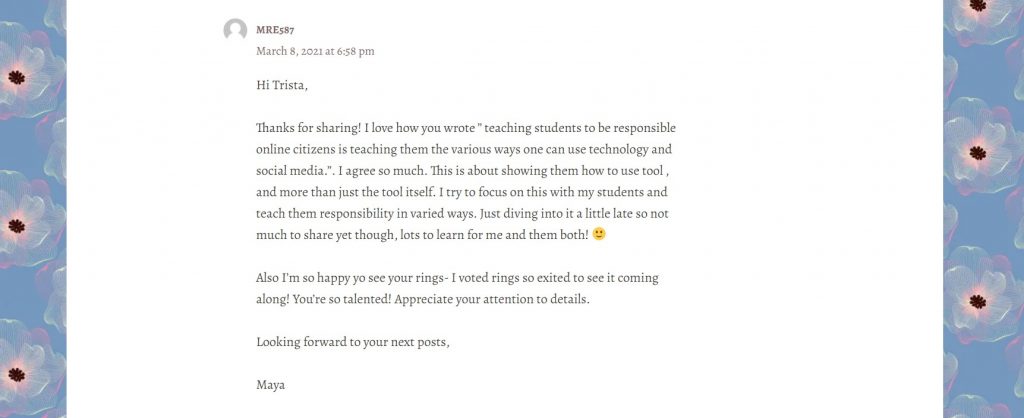
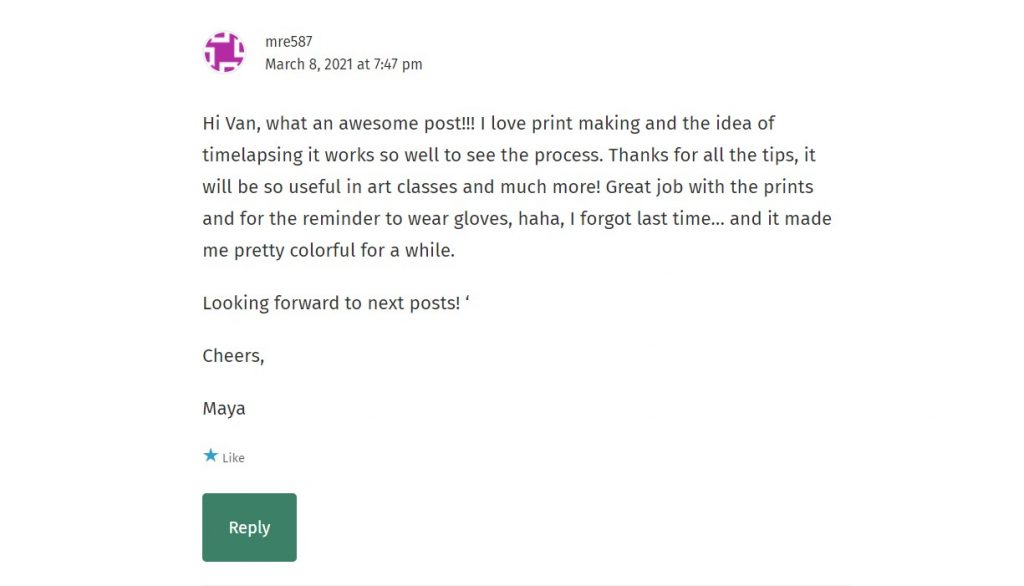
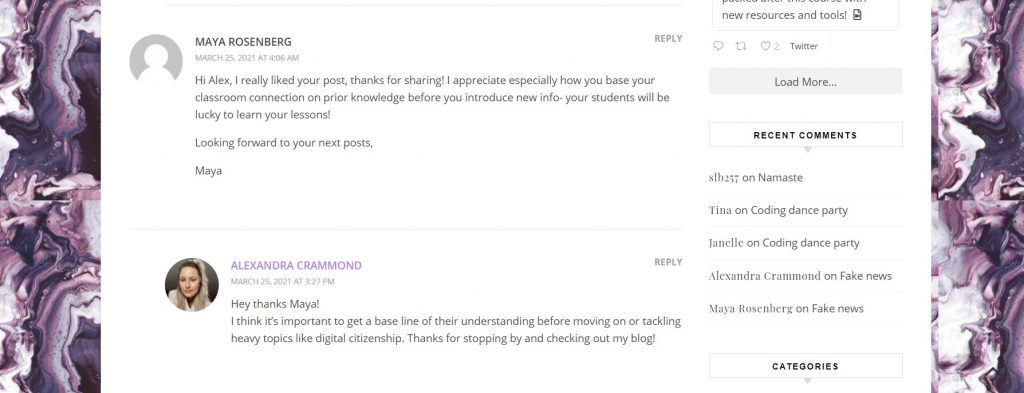
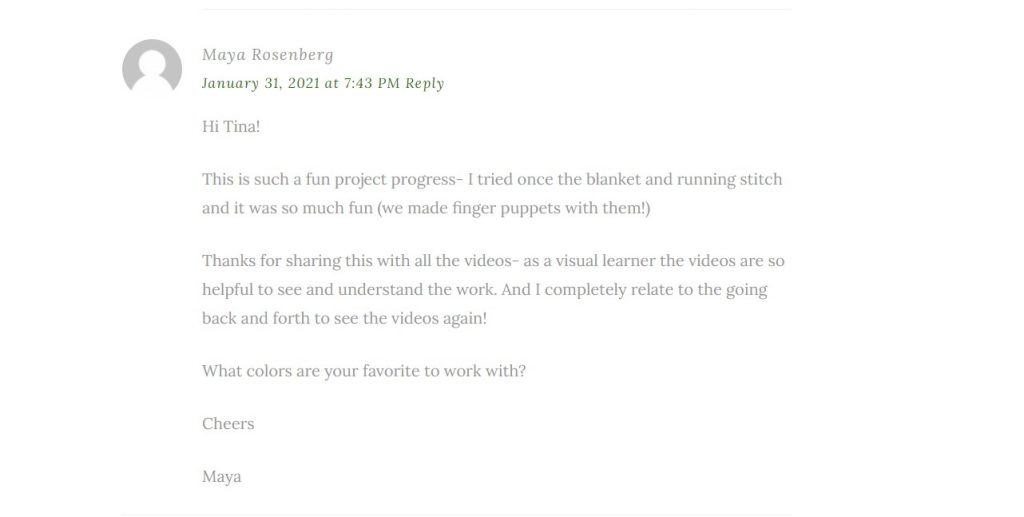
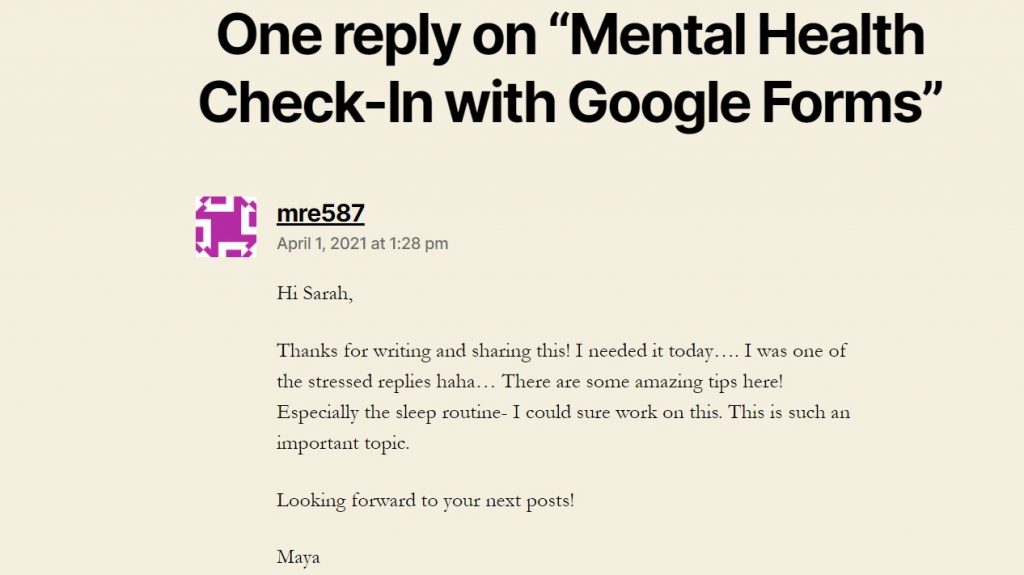
…
Slack community contributions
Slack was a great platform to have – this was the first time I opened a slack account! It was a convenient and clear way to follow up on Q and A that may be helpful, and more. Twitter is also good for it, but it can get too stimulating, and I found Slack to be more clear and smooth. Here are some of what it was great for:
Resources sharing!
Because you can never have too many math teaching resources… 😉
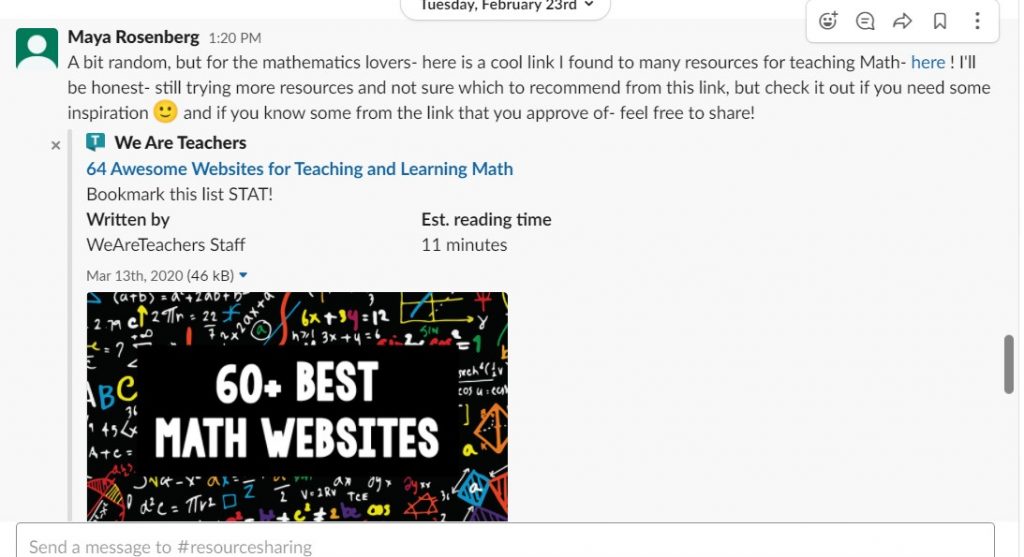
And assessment tools that I found and fell in love with (it feels like magic when you find something that works like 5 combined tools!)
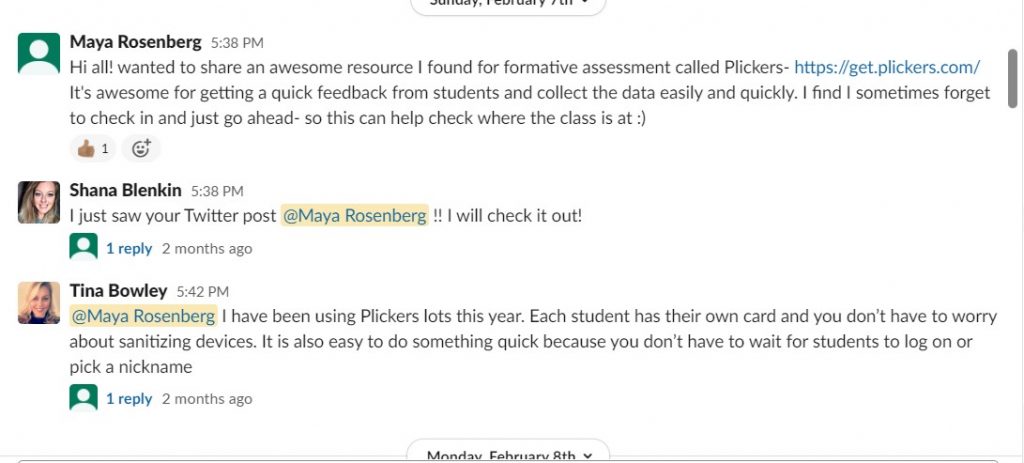
keeping in touch and engaging with classmates:
Visible Learning resources (which I love!)

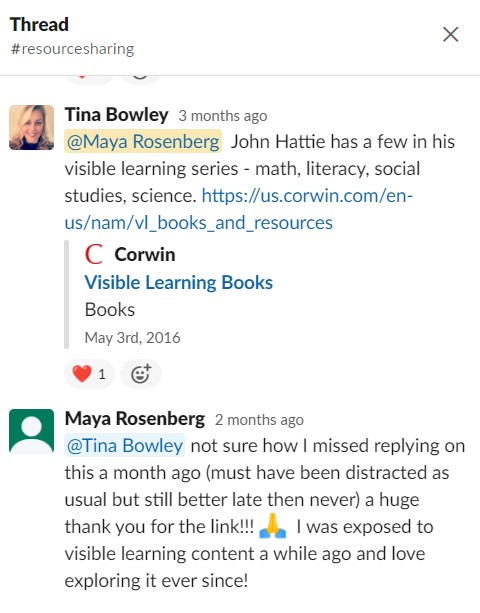
Some more math Ed. resources! (did I say we can’t have enough?!)
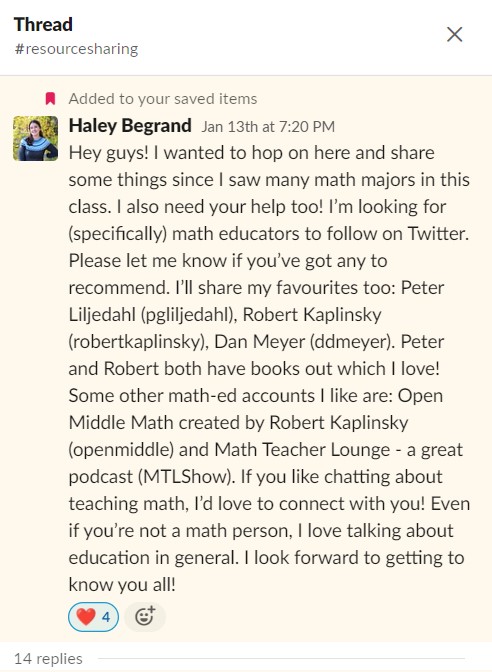
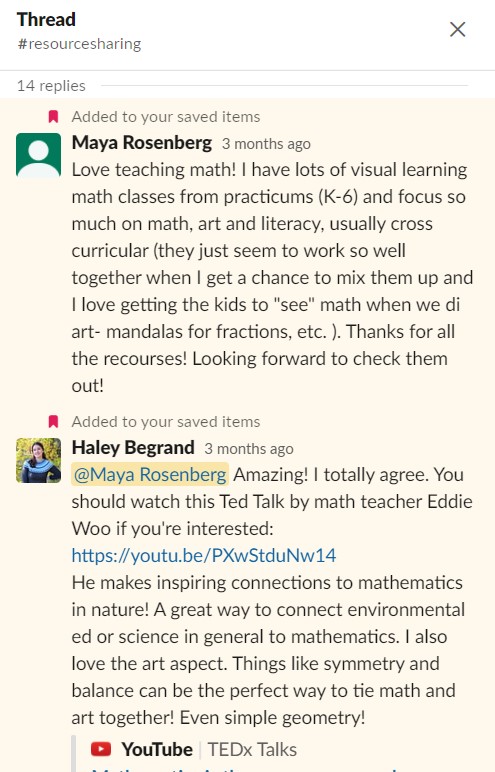
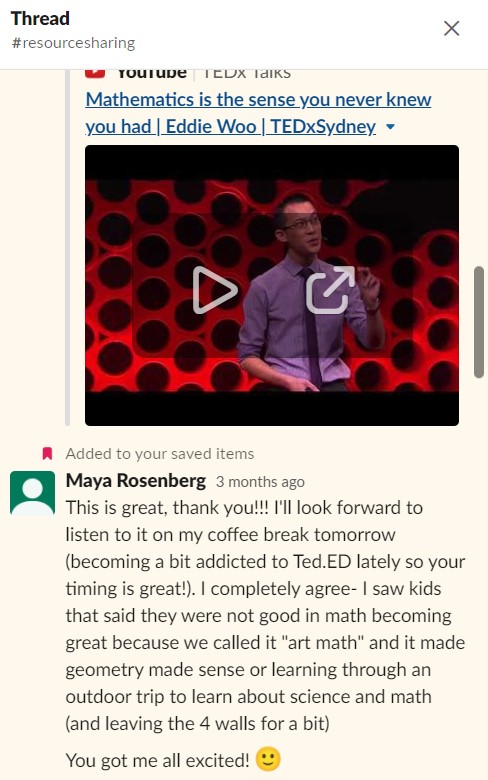
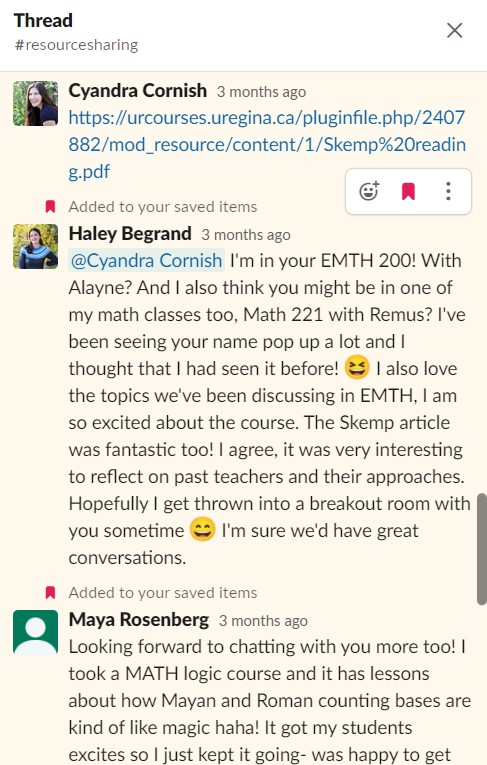


Taking part in classmates’ projects
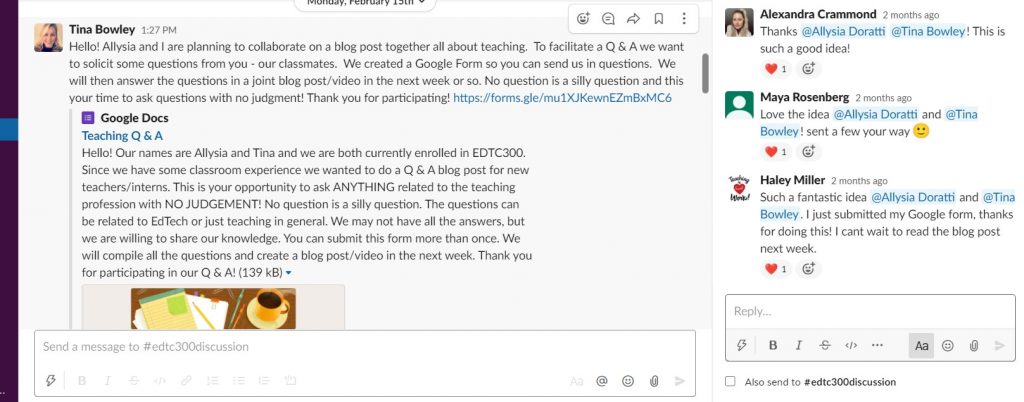
Twitter world contributions
From twitting maybe 10 times my whole life, to logging in daily, it was a big change! I was not a fan of Twitter to start with, but TweetDeck changed my mind, as well as the wonderful EDTC300 community. I used the hashtags #edtc300, #saskedchat, #arteducation, #NASA (they give me the best cross-curricular art- science classed ideas!) #hourofcode, and a few more. In the future, I’d like to get involved more with these hashtags, more frequently, as well as get engaged with #bcedchat, as the Yukon curriculum follows the one of BC. Twitter was such a great tool for building community, sharing resources, and more! It was sure a great platform to learn with.
To start with, it was a great tool to weekly share my blog throughout the semester, starting with the very first one :
And taking part in classmates’ research

As well as for sharing resources at the same time as connecting with our #edct300 community and building on each other’s ideas!

And more resources, some from browsing Twitter and Feedly:
Some from my little obsession with TED Talks:
And of course, connecting with others and starting a Professional Learning Network with #saskedchat
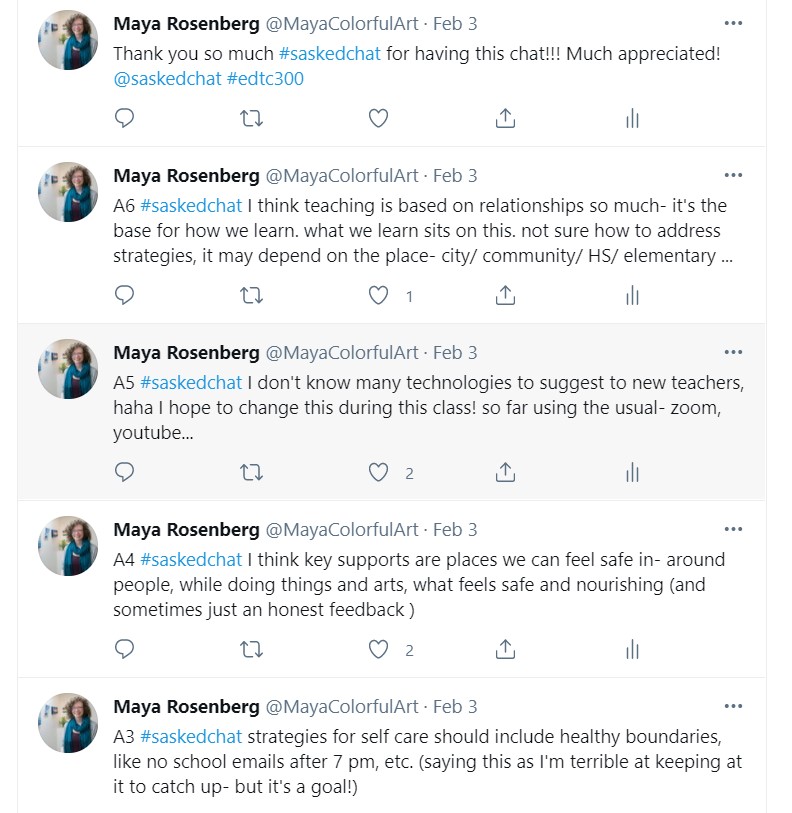

Which led to meeting, connecting with and following new inspiring people:
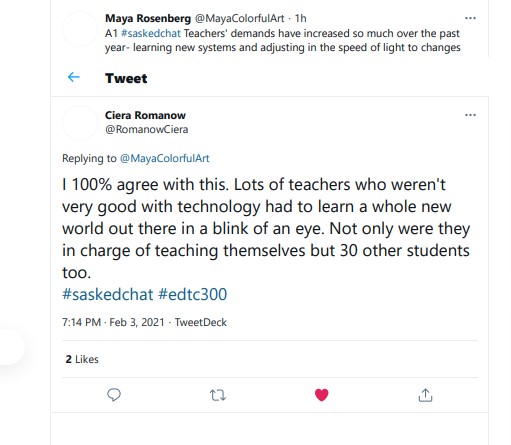

My blog’s connections to others
Also, a huge thank you to Tina, Callen and Branden for being helpful with online tools, to Kassia for reaching out to me on an online project I was struggling with, and to Haley for also many helpful tips, reaching out to help, and being my partner in crime at the Cyber Sleuthing post.

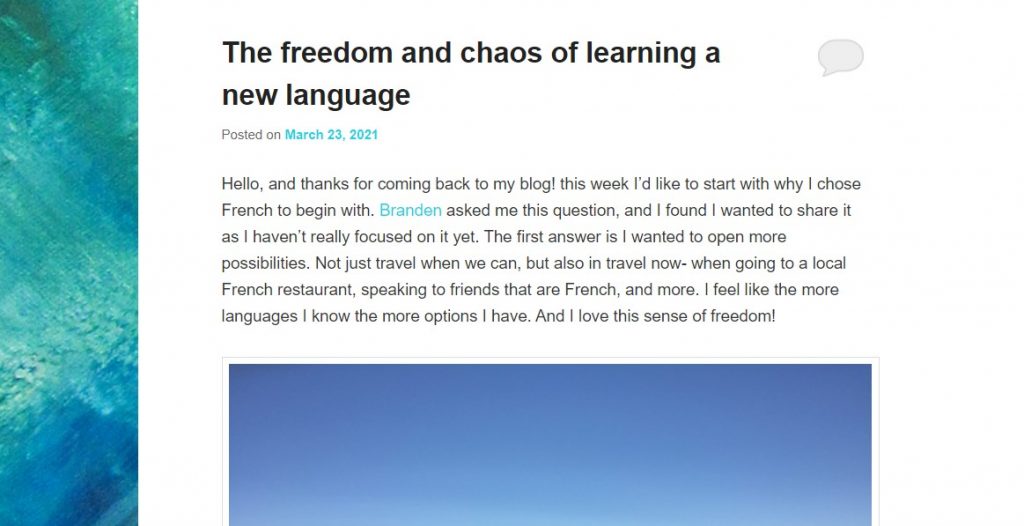
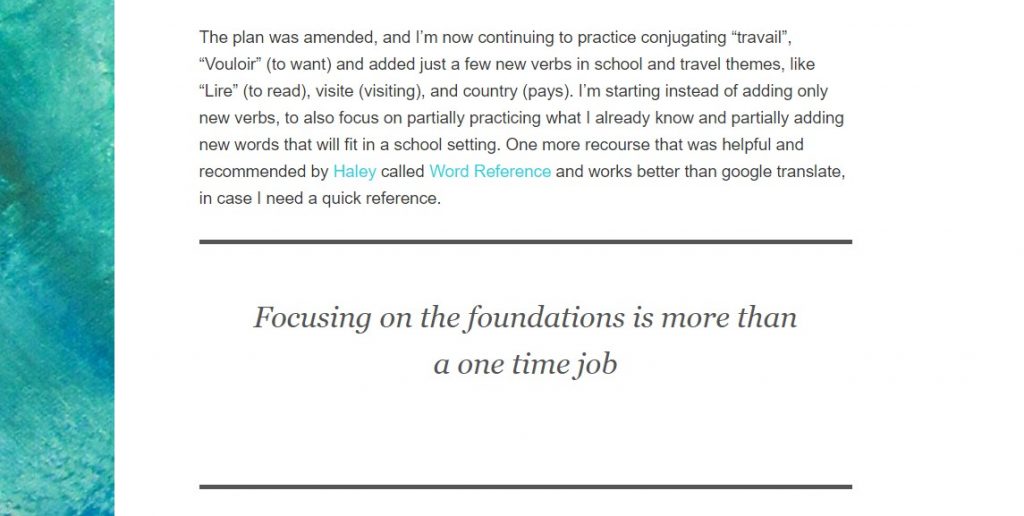
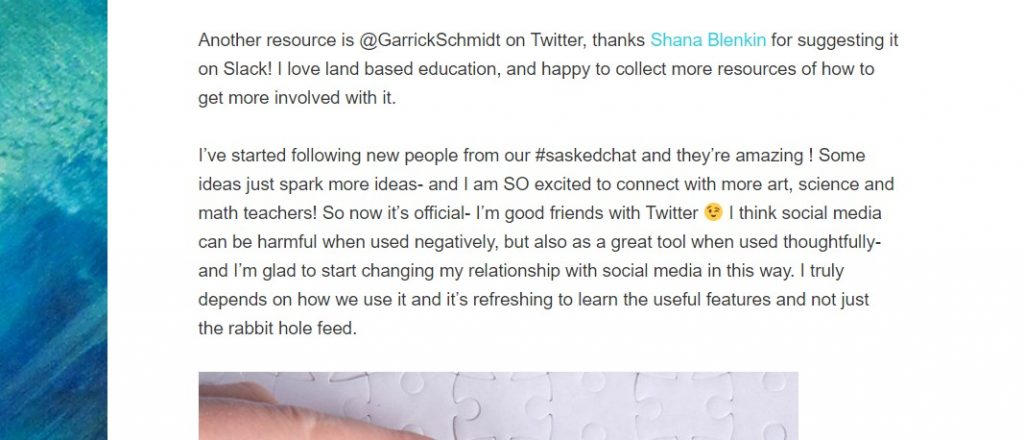

A huge thank you is overdue to the amazing EDTC300 community. It was inspiring and wonderful to meet everyone, learn together, share resources, help and get help, and create this blooming learning environment. I’ve met so many people with whom I have much in common, who are also super passionate about teaching and professional development, and with whom I felt like I have lots to contribute as well as lots to learn from.

Maybe it’s also the spring finally coming back, but I feel like there’s so much creativity ready to grow, use the new tools that were developed, and get creative!
Looking forward to keeping in touch and seeing everyone’s future adventures and creations!
With lots of love,
Maya
This week for my EDTC300 class I learned a little about coding with Hour of Code activities. It was not something I thought I’d do well, as every time I hear about coding my stress level goes up. And this week was challenging to begin with. Though I realized after an hour of playing with it, that it was more my idea of what coding is, rather than what it really is, that scared me.

I got so nervous from coding I forgot how to problem solve the simple things. Luckily I have the most helpful and amazing classmates, that helped me quickly. Tina and Callen were helpful in how to take screenshots with keyboard shortcuts, which made my writing so much faster.
It was this big and complicated thing in my mind, and even though it sure can be complicated, I can still learn the very basics in a simple way. And even fun- which is why I chose a playful theme. It reminded me of what I learned mostly this EDTC300 semester – I can do many things I never thought I could, if only I take it one, and only one, step at a time, along with an open mindset. Allright- ready for my first coding experience? Let’s go!

I chose Star Wars- and was not disappointed! They even started with the theme scene as in the movies. The first thing I saw later was an inviting video. I chose the “blocks” option to learn with. The game started with a clear instruction and showed how to attach the “blocks” one after the other. It had a fun music, and took me just one step at a time. Just what I needed. The more stages, the more challenges I had and more kinds of instructions and options.
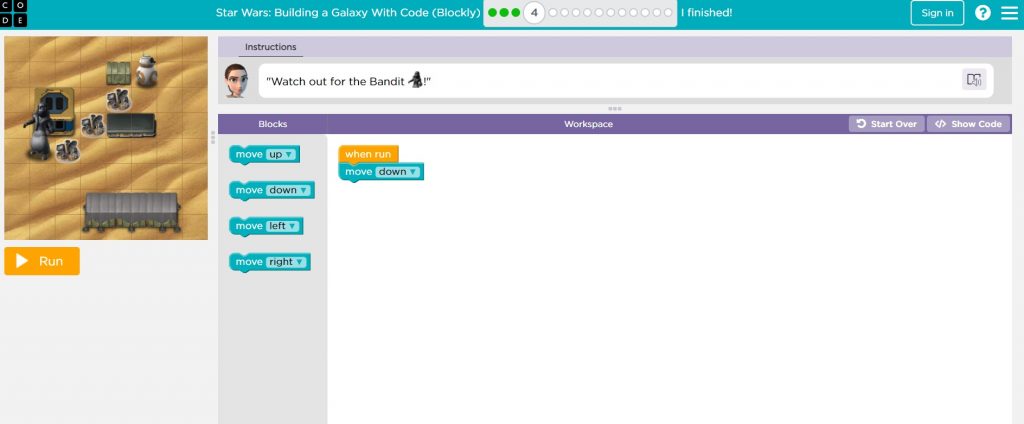
It even had the option to show mw the code if I wanted to:
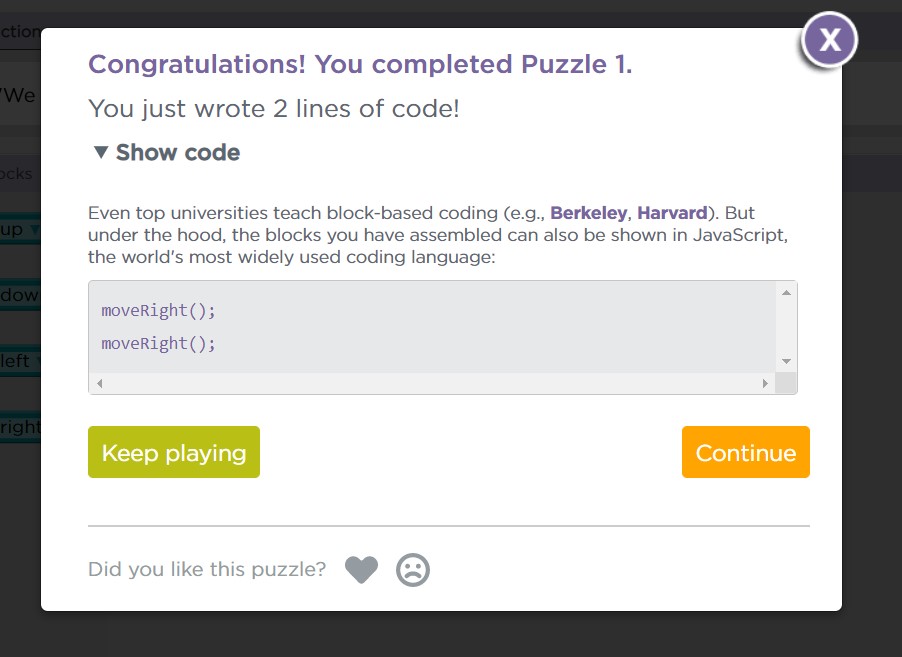
And it got more elaborated with additional commands, and added some good and bad guys to the scene:
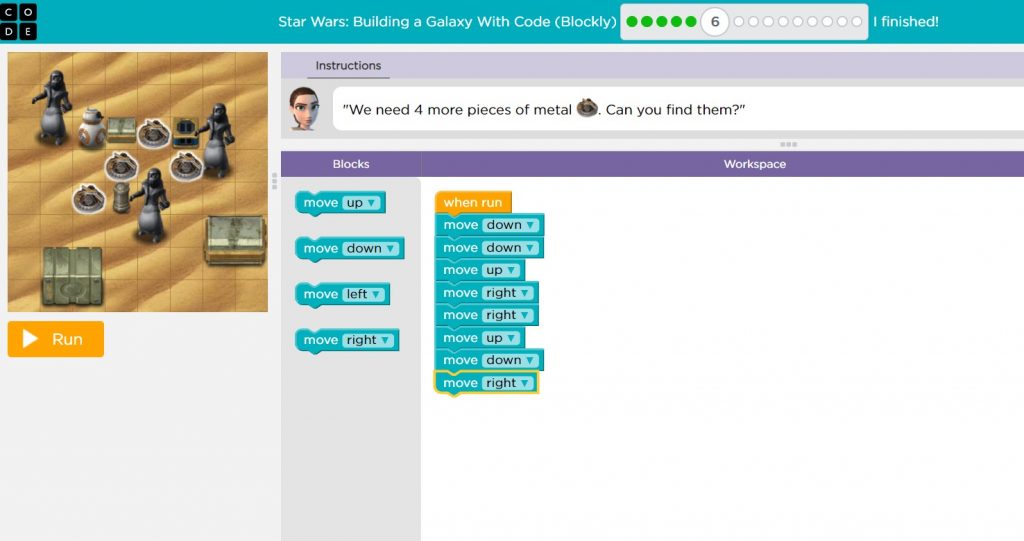
Next, we had a new idea introduced: Events. This is when you attach a code to an action. For example: when we do… we get…
I could also add different speeds, and change the scenery. The more I learned, the more freedom I had with more choices. Yet instead of being overwhelming, it was actually clear and nice.
This was getting pretty interesting! Who knew I’d actually enjoy coding?!
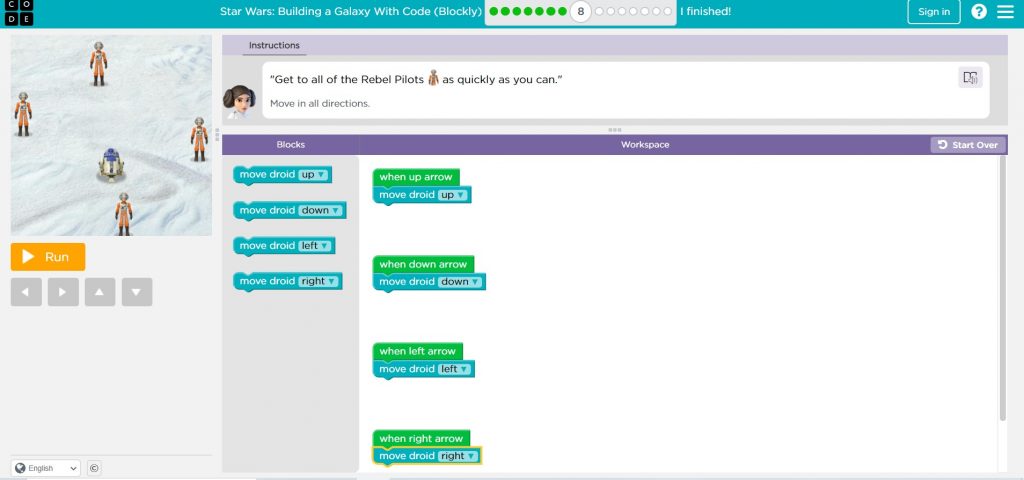

At the end, I got to make my own little game. I played with it for a while, changed it, and than decided to make one where once you take an action, you get one good and one bad guy. The good guy gets you 1000 points (why not?) and the bad guy takes away only 300. Easy! But here is the even easier part – none of it matters, to win you only need to get to one other character! Makes no sense, but was fun exploring! I stopped after a while of changing it (I’m still very slow) but it was overall a positive coding first experience. Here is a link to the very short game I made:
https://studio.code.org/c/1357944983
And my certificate!

Why is coding important
I learned so much from this coding adventure! I learned:


It can be as complicated or a simple as we choose it to be!
Coding is becoming a part of education in younger and younger ages.
Learning about it as teachers is a great way to ensure we pass it forward with curiosity rather then dread. For teachers to be, that do not consider themselves tech- skilled, like myself, it’s even more important to teach these topics with fun and not with stress.
I think that it can have so many benefits, and I am actually excited to explore more for my future classes!
What are your thoughts of coding?

What are your experiences with coding? Have you ever done coding before? Have you seen it used well in the schools?
Would love to hear from you!
Cheers,
Maya
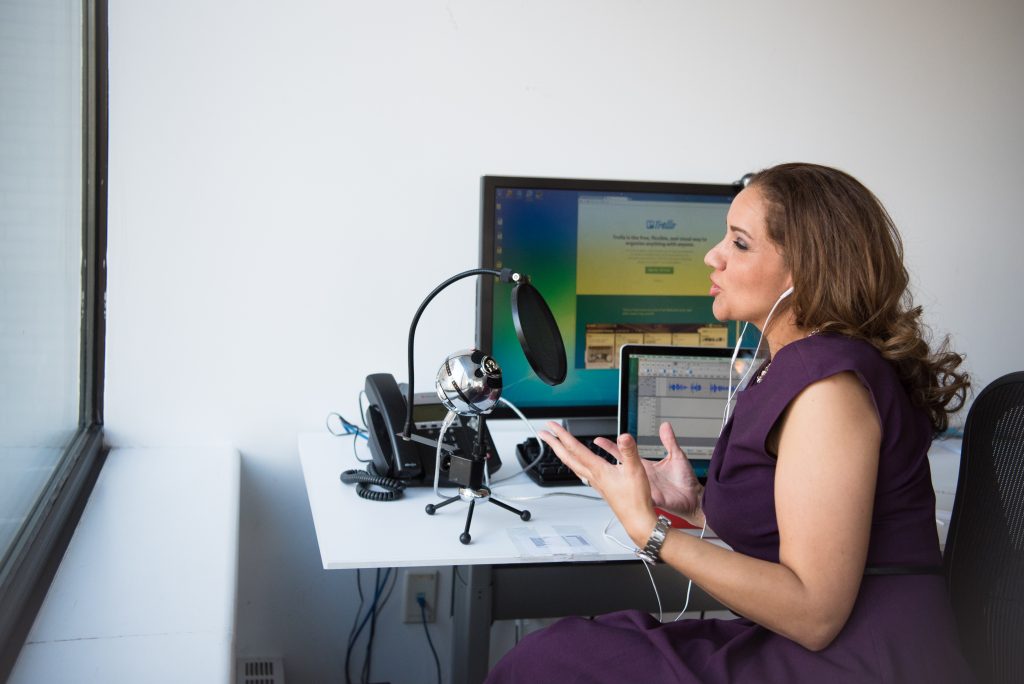
C’est notre dernier projet! Sharing stories in English and French with a colorful podcast
Thanks for coming back for my last learning post and a special new podcast! I’m going to have my second attempt at recording myself in French, it’s exciting and scary at the same time. The winner themes of the poll of the podcast are… (insert drums)… coffee, croissants and art!!!
Thank you to everyone who voted in my poll and chose the themes I’ll talk about- I appreciate it so much. We’ll discuss art, croissants, and how French can help us build a stronger community in the classroom. So grab your coffee and join me as I speak about it all.
It took some more practice but I finally figured out how to do transitions in Anchor. Still need to work on fading sounds away (any help is much welcomed) but it sounds better than last time and the transition sound effect worked in between the segments as I intended it to. Yey!
I also practiced stories in my Duolingo app, where there are stories about different themes and it helps in creating more flow and understanding. I’ve practiced it a lot more frequently as a preparation for my podcast. The stories start with a short intro. As it’s final exam time, I’ll share the story about exams first! 😉


They continue with a check-in question, more of the story, and the last question to check if we got the surprise element at the end (Duolingo likes to give a story with a twist!). The final exam story was a few more slides and ended with everyone being ready and happy. The next story was about a museum:
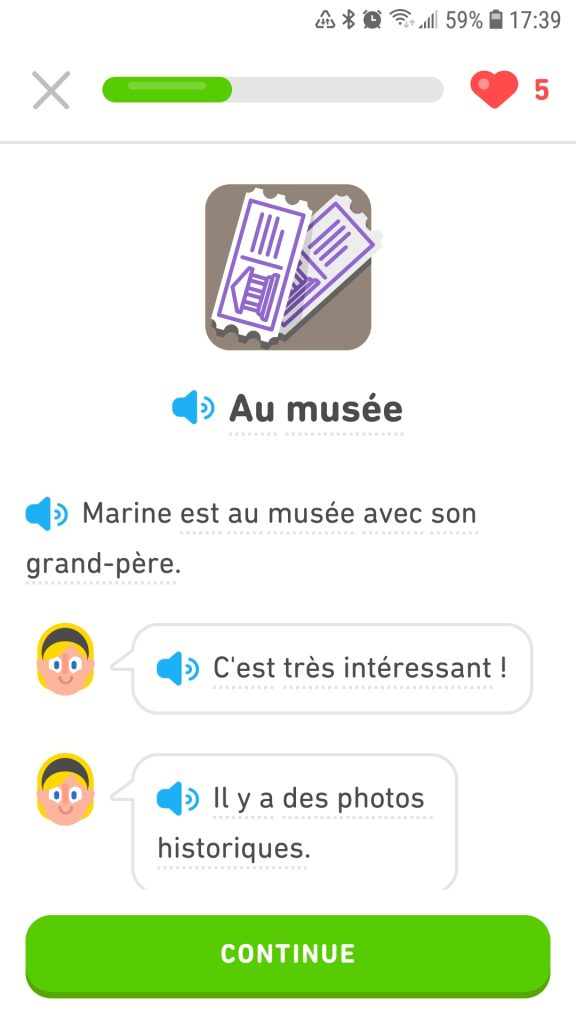
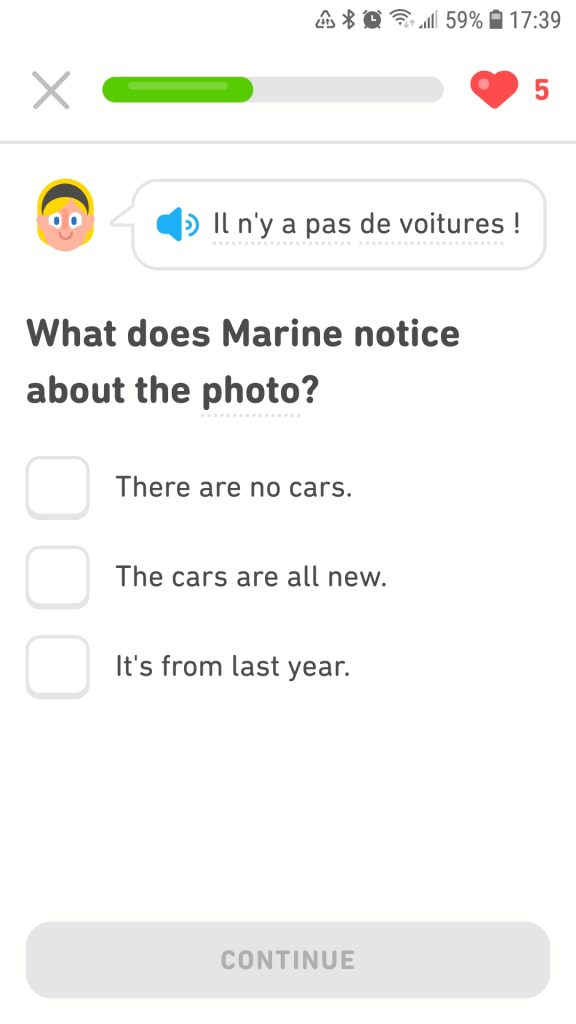
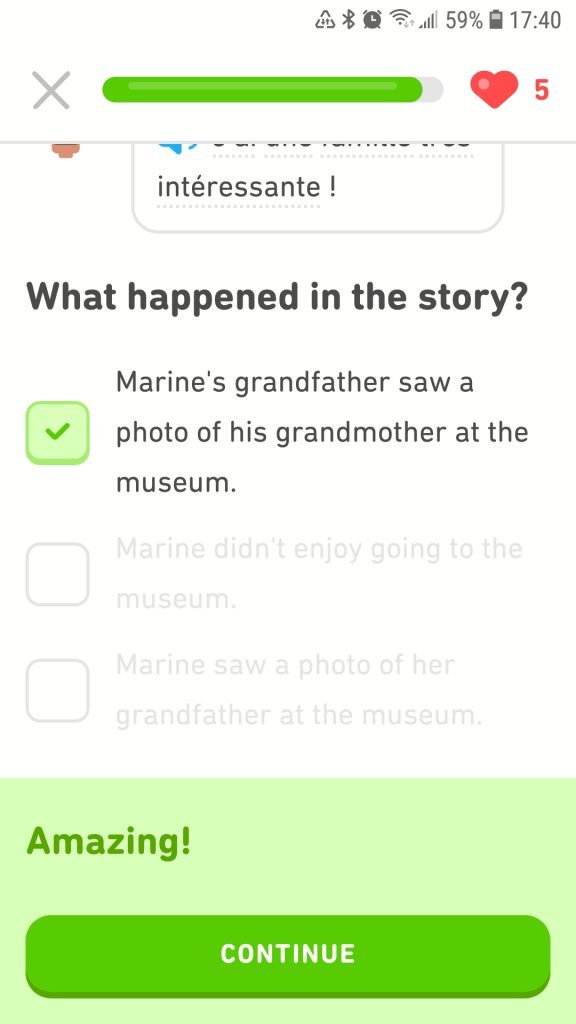
Here, it was a bit more interesting and the visitors found a picture of their family in the museum. It keeps leveling up the difficulty, details (so it’s more and more interesting), and new words. Here you can see the exercises it gives about matching words, and a little badge at the end to make me feel good for the work. There were lots of new words in these stories, as the stories were about themes from groceries, food, art, and a little bit of everything. The stories help so much in creating flow and understanding and were a great prep for the podcast.

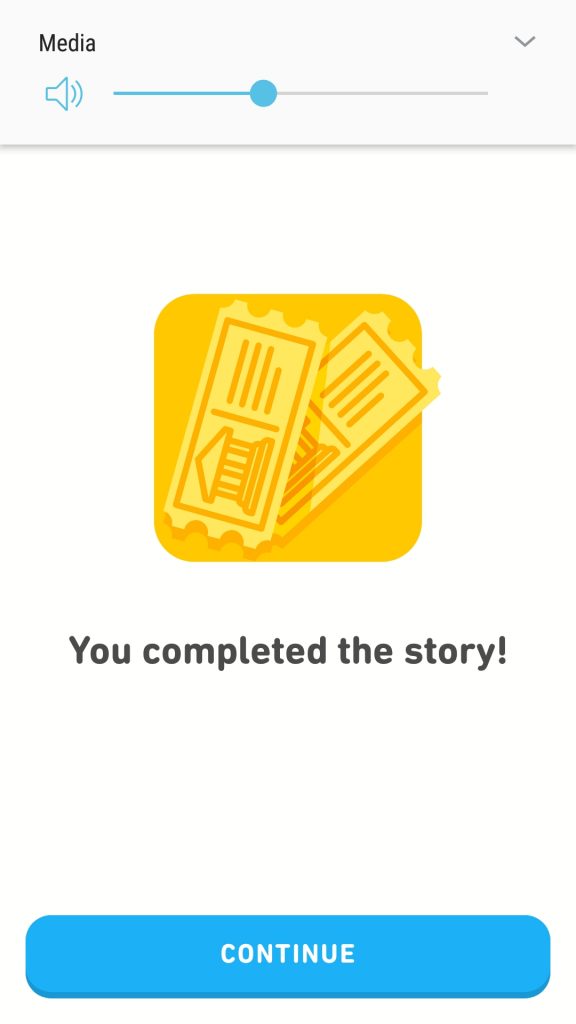
Learning Summary
As we’re wrapping up the EDTC300 learning project, I’d like to summarize what we had so far, and how it build up and lead, progressively and one week at a time, to the last podcast as the final learning outcome.
Week 1:
Resources and tools: TalkingFrench video, Doulingo app, some fun songs from Spotify!
Learning Highlights: Setting up my goals, setting up a poll for final project, the verb “Etre” (to be) meaning and conjugation
Week 2:
Resources and tools: Doulingo, French with Vincent video
Learning Highlights: the verbs “Vouloir” (want to) and “Manges” (to eat) meaning and conjugation, focusing on food themes.
Week 3:
Resources and tools: “French Truly” for conjugation, French learning blog for numbers. Doulingo for weekly verbs practice.
Learning Highlights: the verb “Avoir” (to have) meaning and conjugation, counting numbers in French 1-100.
Week 4:
Resources and tools: Learn French with Julie Video for colors and Quizlets. Doulingo for weekly verbs practice.
Learning Highlights: learning colors in French. Gaining confidence (checking in with goals from lesson 1) and having my first French podcast on Anchor.
Week 5:
Resources and tools: article at Read Naturally and exploring new resources at this link. Doulingo for weekly verbs practice. “L’aurore Boreal” newspaper. Google translate and Language daily.
Learning Highlights: Check in and stepping it up! Mindset of learning new language focus, poll on themes for final project, revising verbs and getting learning habits instilled better in my routine (goals of lesson 1). Connecting my learning to the community and checking local French newspaper. checking in with “language daily” to see choice of future verbs to learn.
Week 6:
Resources and tools: Doulingo, our French local newspaper and Screencastify.
Learning Highlights: French masculine and Feminine grammar, local newspaper stories, starting to put meaning and sentences together in writing and reading.
Week 7:
Resources and tools: TED talk for motivation , Doulingo, Word Reference.
Learning Highlights: school and travel themed words in Doulingo- increasing vocabulary. Words included “travail” (to travel), “lire” (to read), “visite” (visiting) as well as “pays” (country). A thank you note to Branden and Haley for helpful tips!
Week 8:
Resources and tools: La Vie En Rose, Duolingo , Aux Champs Elisees, French Propositions.
Learning Highlights: learning through music: keeping the motivation up! spelling with Duolingo and prepositions with YouTube videos in resources.
Week 9:
Resources and tools: Fun TED article, Doulingo
Learning Highlights: learning the theme of “people” in Duolingo and building more complex sentences in reading and writing, as well as identifying more proper pronunciation in listening and speaking with Duolingo.
Week 10:
Resources and tools: Duolingo, Anchor
Learning Highlights: Final podcast! and checking off the goals from first class. Also learning through stories in Duolingo to prepare for the podcast and create more flow in my French (focus on speaking).
Thank you!
Before I finish the post, I’d like to send one more huge thank you. This class has been so very supportive in this learning project, from tips, kind words, helpful advice, and much more- you made this possible and fun at the same time.
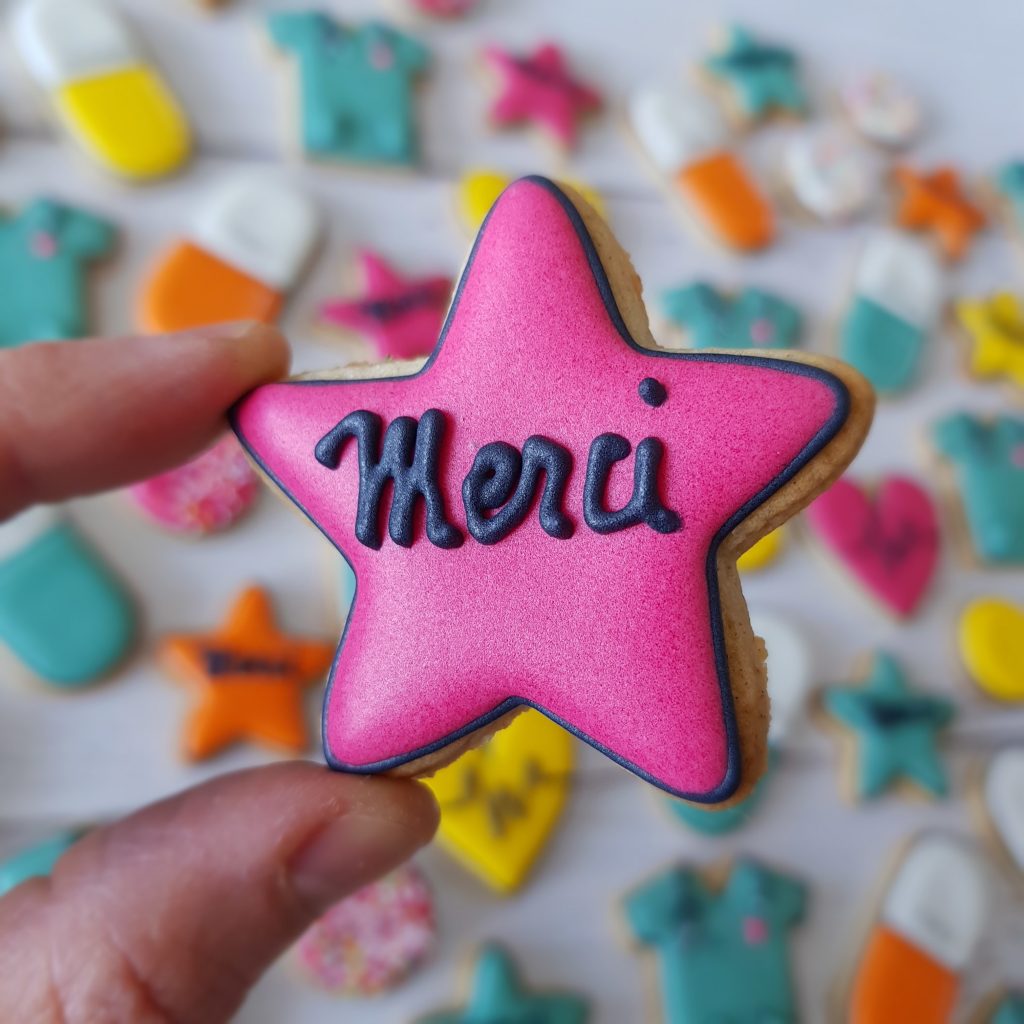
Merci! Merci! Merci!
Maya
Hi all, thanks for coming back to my blog! This week I learned and practiced some old-new themes and tried to create more flow, some more ways to learn and teach in mind, and am getting excited for the upcoming final project!
This week I first focused on taking “people theme” lessons in Doulingo, determined to make it to level 2. I went to level 2 in “travel” and other themes, but this one has been hard so it was time to tackle it. I am struggling with conjugation and this one has lots of it! I had my class prep focusing on sounds and spelling (can never practice this enough!)
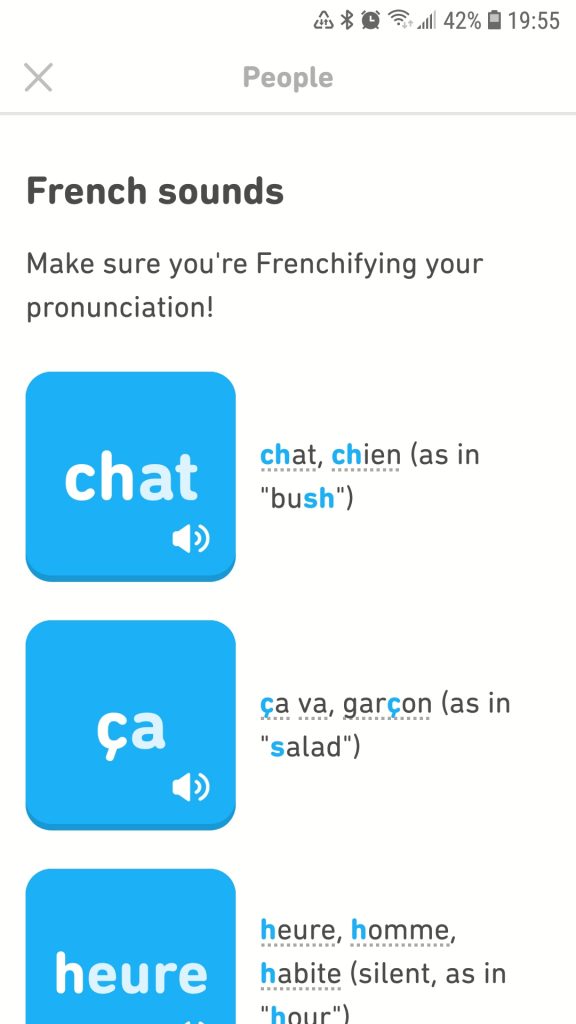
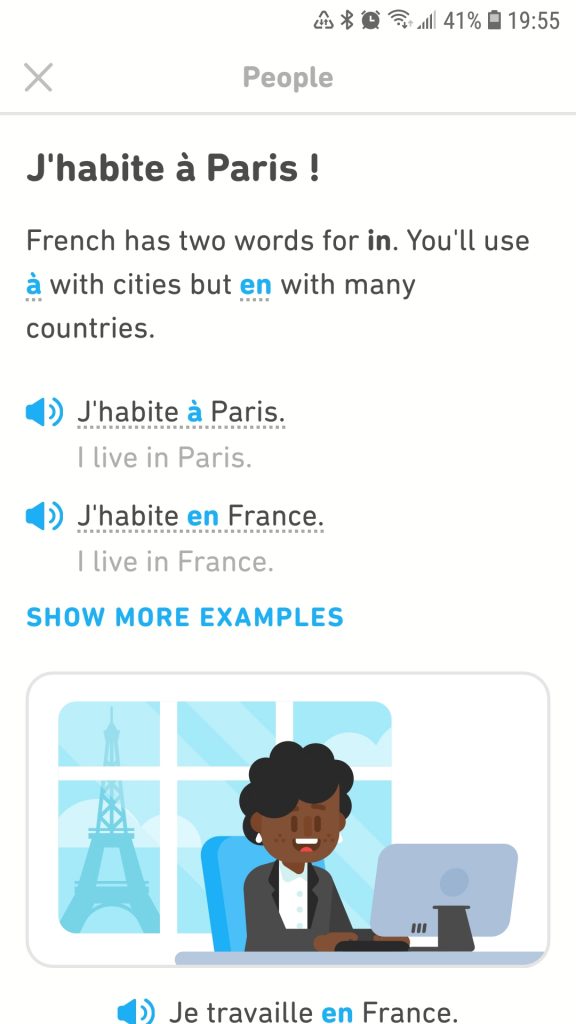
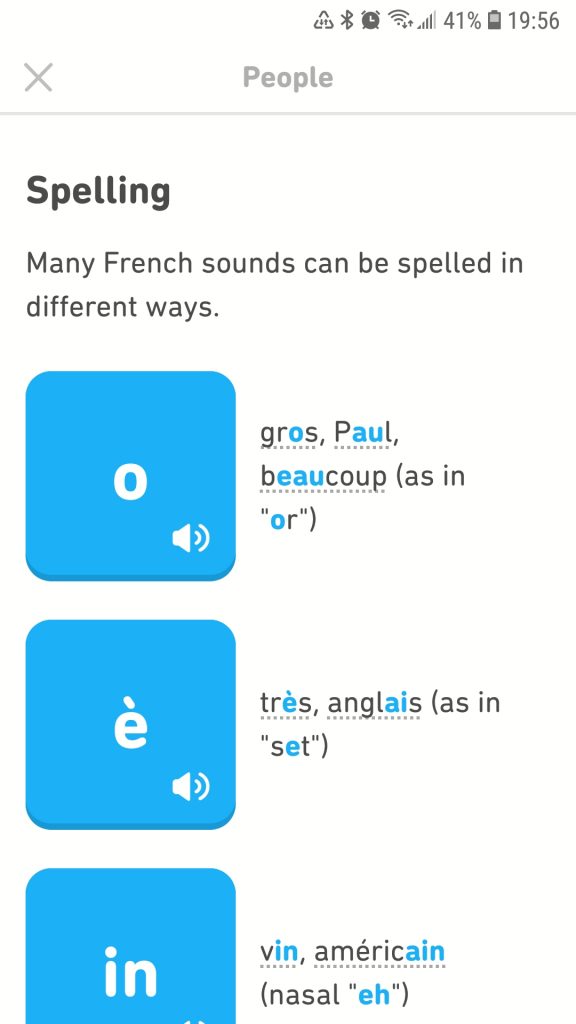
It then continued to a few easy practices, until I reached this harder following one. It took a while to get the details right, and especially to learn that “etudiant” means students, and “etidients” means study. Back to the confusing “a” and “e”! This one tested my patience. It took a while but I finally got it. Here is a few screen shots from a failed attempt and the tips that helped me with it. I usually post the “success” ones but decided to also share some of the “fail” ones. It’s all a part of the process!


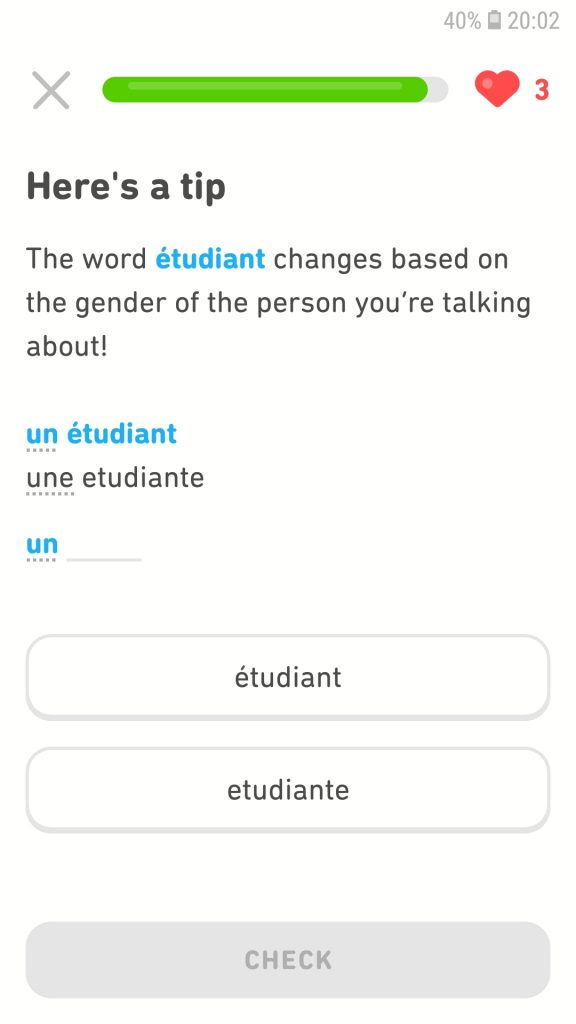
Two new things happened this time. All my additional attempts cost me the hearts at the corner, and I needed to refill them. I went so overboard and ended with an infinite sign instead! It’s like a computer game! Here are two harder exercises (the sentences are getting longer) and a tip. I do appreciate Doulingo gives me tips when I fail, before letting me trying again and again with the same mistake. I think this is something to remember in the classroom: when a student is struggling let’s remind them a “tip” and not just go again and again without what they need, even if it’s revising the basics.
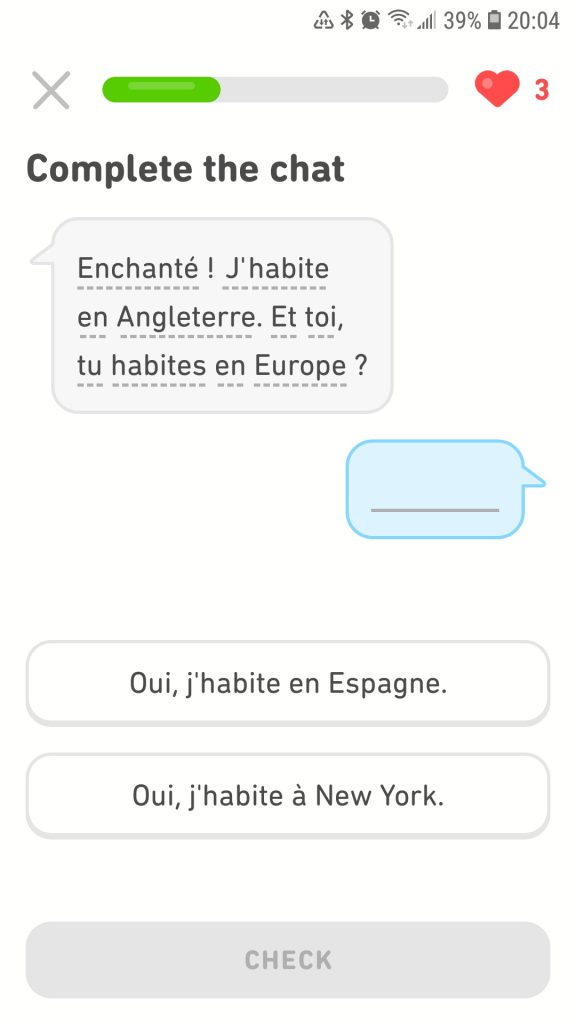
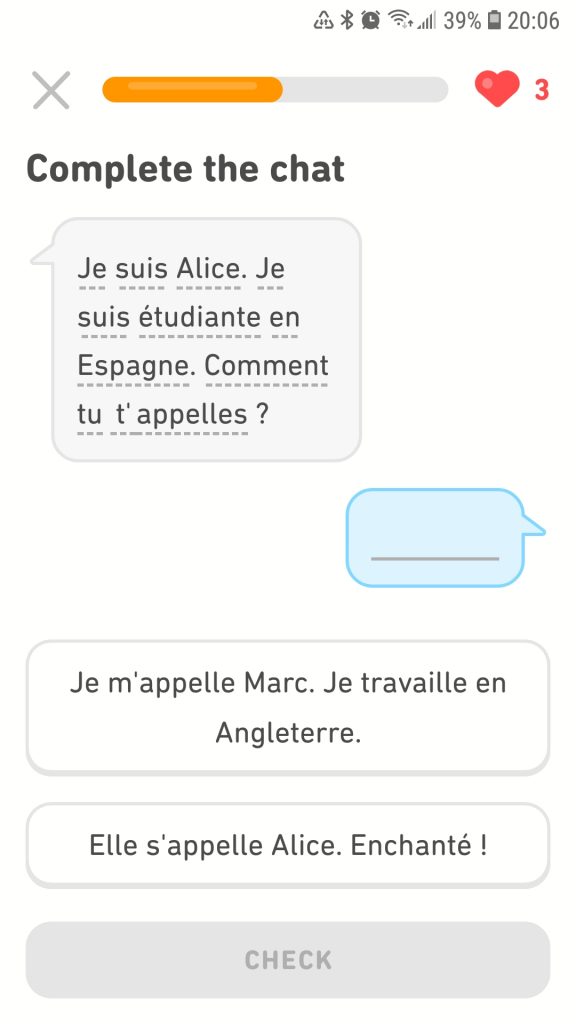

Eventually- mission accomplished! I jumped to level 2 in “people theme”! wehooo!!! Honestly, this week’s focus went to the details in conjugation and understanding the similar meaning in sound-alike words. This felt like a LOT! But I did get this:
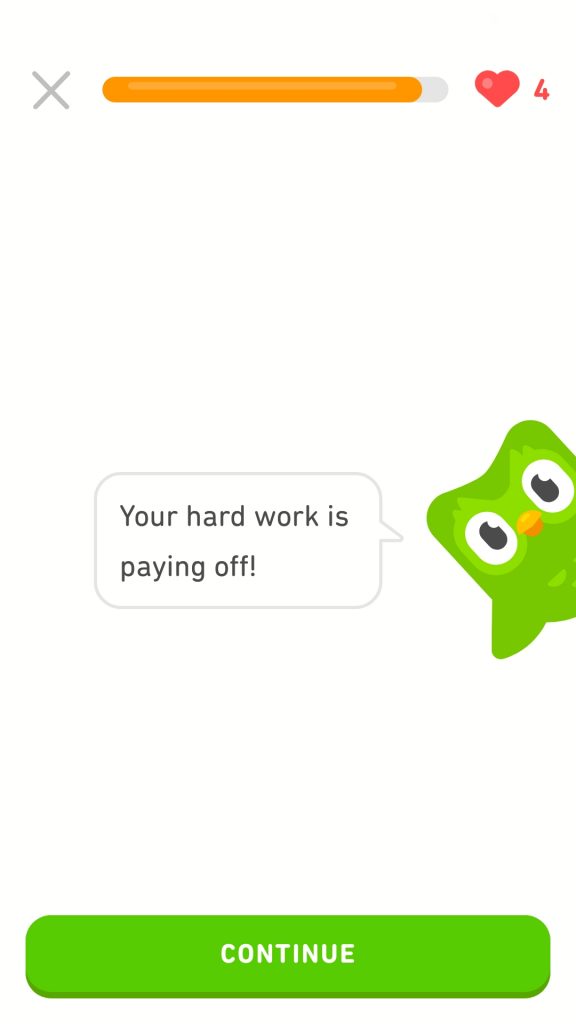
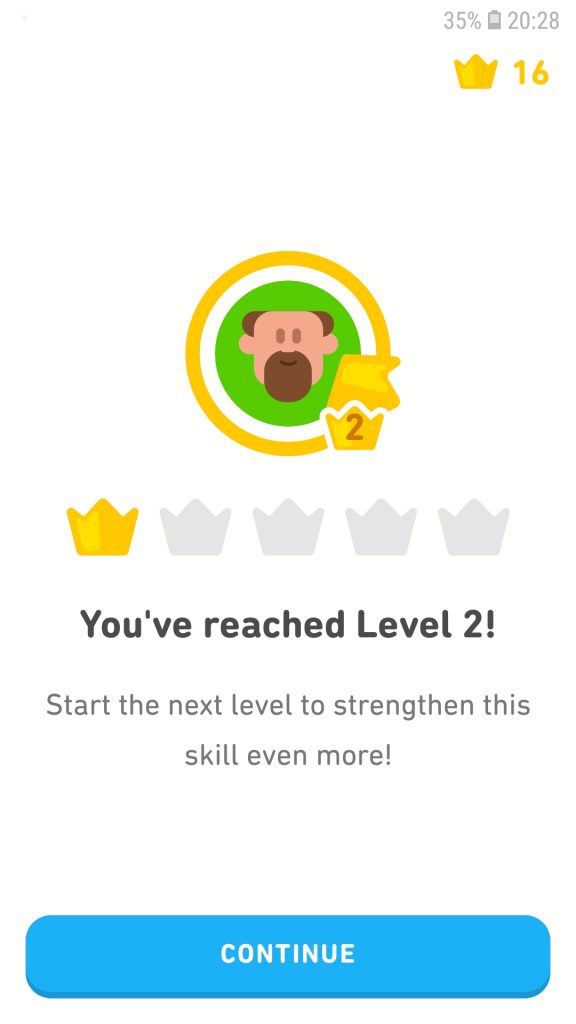
This is all my brain can take this week… learning many articles in my first or second language is ok, but reading even just a little in my French third growing langauge is a new level of brain tired. I’m learning this week, as the levels get more difficult and learning methods expand, different ways to learn new things. Taking this into the classroom- I’ll try and learn from the app how a variety of ways to learn works well. It’s not just that every student learns differently, but even the same students may need different ways from week to week. Like I did this week.

This week, I’m going to focus on these elements, as I am getting ready to make my final project in French. I am nervous about conjugations and small mix-ups, so will keep focusing on these as well as creating flow. In this Fun TED article, we can see a discussion about how to be funny in different languages. Creating a flow, staying funny, making sense- these are all things that come with practice. I’ll get my verbal practice in flow, the one element I can’t get from videos and Doulingo, in my final project podcast!
Be brave enough to suck at something new
Until then, I’ll get going on some more ideas and flow!
How do you create a flow when learning something new? How are you preparing for the final learning project? Would love to hear from you!
Cheers,
Maya
As my highschool teacher would say when asked a question: either yes, or not, what’s for sure is a maybe and I doubt that too.
Ohhhh I loved this answer! It was encouraging to critical think about what we ask. It was also a fun answer, and given in many physics context questions (this was his teaching subject) but it stuck with me. He would give an answer to the lesson, but also encourage us to ask more- and differently.
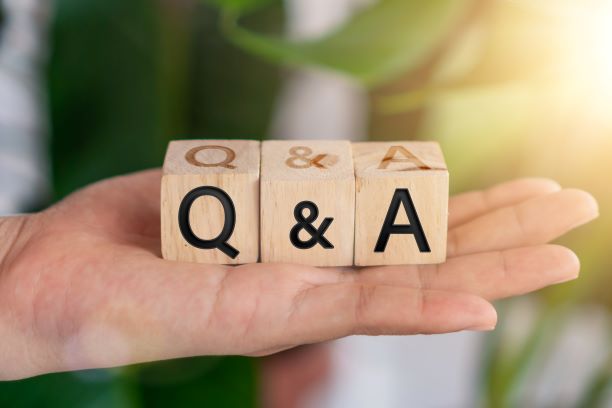
Start with this fun “The Oatmeal” comic to get the idea. Challenging and changing our minds is ok, and necessary, for growth. This week in EDTC300 we continued to learn about Digital Citizenship, and I’d like to touch base on Fake News. We have so much of it, and youth today is far ahead on the technological exposure spectrum than we’d like to believe. It’s now, more than ever, crucial that we teach critical thinking and practical tools to learn about this. Ditigal literacy is a great way to start.
It will depend on the classroom, grade level, etc. but can always be taught to some degree. When I worked with Kindergarten, they used IPads and even though they had no freedom to roam the wifi limits, they sure knew what they were doing in their play app. And in no time they’ll know more about their IPads than me. Kids learn from us not just what we teach, but also HOW we teach. I’ve read some of John Dewey‘s work and focused a lot on the idea that the experience we trach with, and not just the content, goes such a long way. Whether we teach digital literacy with a critical thinking mind and not a fear state of mind can make a large impact.
“I’ve learned that people will forget what you said, people will forget what you did, but people will never forget how you made them feel.”
― Maya Angelou
We can make this connection to the curriculum (in this case it aligns so well with the BC/Yukon curriculum I’m working with now in schools in Yukon) in many ways, from critical thinking topics to core competencies, to ways to collaborate and have lessons to decide “is it real or fake” news. We can do so while incorporating the goals of the NCTE framework by emphasizing exactly this critical thinking attitude and learning how to ask questions that open, rather than close, options.
“It’s not enough to be connected; we need to be accurate in our knowledge through these connections”
ABBY HEVERIN
It can also be taught by building on prior knowledge blocks (exploring news we’ve seen and haven’t seen) and stages of development (inspired by Piaget’s learning philosophy). We can not do so once a month and be done- but embed a way of thinking in everyday learning.
Informing ourselves can help, such as with this article about How Complicated Fake news are. It brings important points about what kind of content is shared, why, and how. It adds the misinformation (unintentionally) and disinformation (intentionally) sharing of fake news, and the complexity of it.
This TED talk talks about how to choose our news. Consciousness in what is in our “feed” could be a huge impact. When we choose our news, we question it already. We can have a look at how we look at things from multiple points of view. This is a great way to teach how to ask questions, something that can help so much in this way. Asking ourselves:
This can grow so many seeds, in unexpected ways. How do you think about these issues? How do you think these topics could be taught in schools? how would you connect this to the curriculum and learnings across ages in a safe way?

Would love to hear from you! Let me know in the comments! 🙂
Cheers,
Maya
This week we discussed in EDTC300 digital identity, cyber sleuthing, and how our digital life and in-person life impact one another.

I’d like to share with you first my thoughts about the Monika Lewinsky TED talk.
Monika Lewinsky’s TED talk brings us a perspective that was not shared before- her narrative and how she claimed it. When I saw the news in 98′ about the affair, I was pretty young, judgy, and not very informed. This was eye-opening to hear about her experience and consider digital forgiveness, digital awareness, and digital identity. Otherwise, the impact of cyberbullying can be devastating.
Lewinsky says she was “seen by many, known by few”. This is a powerful way to describe the issues that come with social media. She also describes how “online, technologically enhanced shaming is amplified, uncontained and permanently accessible”.
When it comes to responsibility for freedom of expression, we can see both sides of the screen. This is how we can make a difference as teachers. Lewinski talks about taking back our narratives, and I think this is a great way to look at it and begin from. Tell ours owns stories – one step at a time. In the classroom, having room for students to share their stories safely and compassionately, either with the class or teacher (I love combining independent work and group work, making stories together and apart, sending to the teacher or sharing with the class- so much room to play and adjust the content to the students’ needs). We can see how we share, on and offline, and how we respond. Doing both with compassion and awareness, to us and others.
The article “Having multiple online identities is more normal than you think” by Nicole Lee presents a topic to consider within this theme, of having many platforms to engage with and be with.

Lee writes about her online platforms: “my audience in each case overlaps to some degree, but they’re not the same.” I feel the same with my business, as I have different audiences and cater platforms and content accordingly. I also feel this way for work, as I have my “teacher voice” which is sharper than usual and you can hear it all the way across the recess field if needed. As Lee says, about her own platforms: “different sites, different audiences, different purposes.” This can be applicable not just for work and life – the article elaborates on how “People have diverse, rich lives that aren’t contained within a single idea and personae…to have us each be confined to just a single account, or a single all-in-one persona, is confining”. I think that being aware of our representation throughout varied platforms can make our voices more intentional.
Yet can we see the impacts of how much info we put out there? when we can be found, throughout all these platforms, how much exposure does it put us in? This is a great connection to our latest assignment, to cyber sleuth a classmate. I am lucky to work with my friend Haley Begrand, and see her online presence as a practice. I was playing detective! Honesty, even with the “ok” from our class and kind intention, it still felt not ok to spy on someone. It made me uncomfortable, perhaps partly because I felt like even though online presence is public, it’s a personal world I’m looking into. And that’s personal.

When I looked up Haley’s info I found first her Twitter and business. She makes the most amazing clay jewelry, if you haven’t checked it yet you totally should on her Etsy shop! I also found her Pinterest, TikTok, Youtube, and other stores that carry her lovely work. I found some pictures, of the same headshot style of her public profiles. It was mostly around education and art- her journey to be a teacher (her Twitter content is awesome, and she just published a useful resource from #edchat of you’re looking for some clarity). The info presented in these platforms, combined, shows her age, where she is, pronouns of choice (which shows inclusive and respectful approach) what she studies, education approaches, art and creative ideas. Even though it’s maybe different “audiences”, like the article above, it all combines and flows well together. The creativity feeding into education and vice versa. Honestly, it’s looking professional and colorful from my research. When I looked at her name in sources not her own, a few search pages in, it was still all linked to education and art conversations and in a pleasant manner. There were awards she won on the Saskatchewan Drama Association, and more creative pins to check out. Which is kind of like a great referral, when a friend of a friend recommends someone! I honestly have no comments to make- other than maybe learning from how she set up the info and make some of these changes on my own platforms.
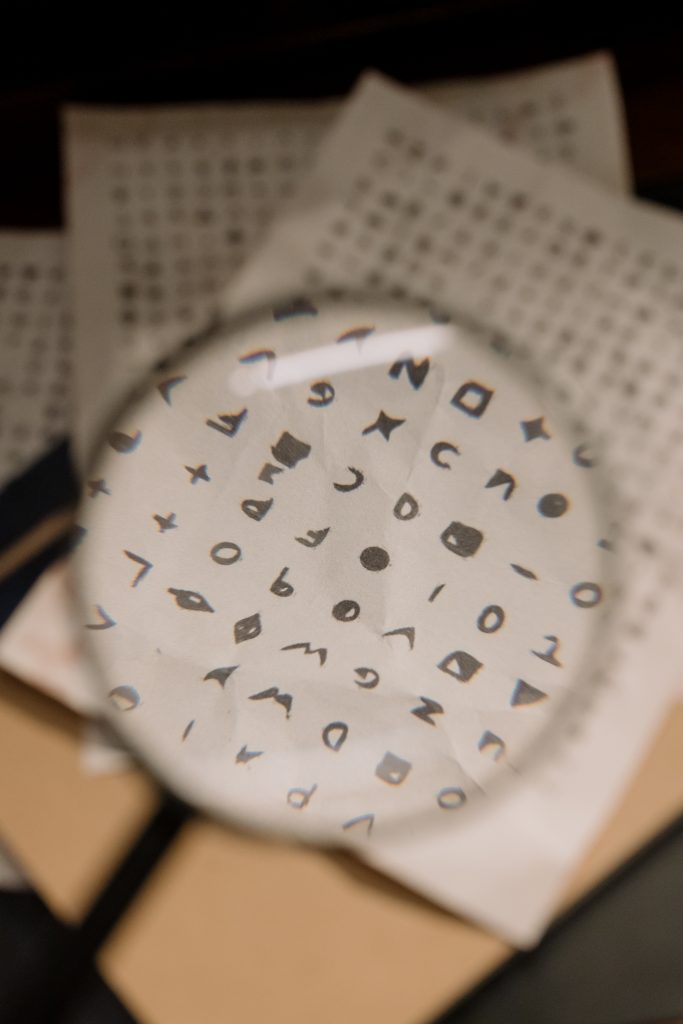
Looking at digital identity feels like decoding a complicated question. It has so many elements, and they are so widespread. I always feel like I’m way behind on online education.
I run a local business and try to keep a professional online presence, yet sometimes miss important things. This course helps me, one step at a time, to do so more wisely.
I’ll end with an idea of how to use this in the classroom. I loved De. Alec Couros and Amanda Brace’s post, as a great way to teach in a relevant way.
What are your thoughts on the topic? How do you find your online presence? How do you plan on teaching this in the classroom?
Chat soon!
Maya
Hi all! Thanks for coming back!
Sometimes we all need a little more music.
This week was a hard one. So I needed a little extra music. I’ll start and finish with it. The first one is this lovely tune from a song my dad once sang, and I love ever since. Have it in the background and let’s go!
In my weekly Duolingo practice, I learned about restaurants, sounds, spelling, using French in a restaurant. So if I’m learning about sounds- there’s the usual “a”, “aux” etc., and some music I needed to make more sound that flows a little easier for me.
This time I spent more attention on the class preparation. It was very helpful to learn the rules around vowels, again, and yes- again. These are always challenging. Adding “d’ ” and not “de”, for example, will take time to get used to. I had little experience in French, but it was mostly in speaking or listening from my travels a while ago, and when it comes to writing and spelling, I feel like I’m starting from the very basic. This is a part of my lesson prep:


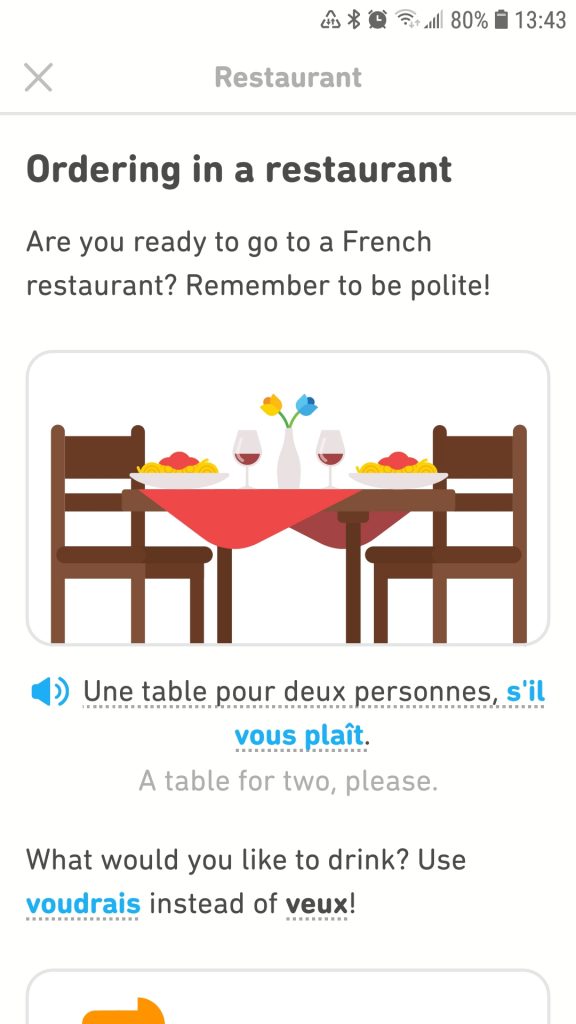
Then I had three sound-related exercises. The first was one I hope to repeat in other combinations, as the difference between “a”, “au” and any other 2 -3 letter combination with “a” sounds so very similar to me! I realize it’s not, just like in Hebrew we have a throat “a” and a flat “a” and it will not sound too different to someone who is just getting used to these sounds and learning the language.
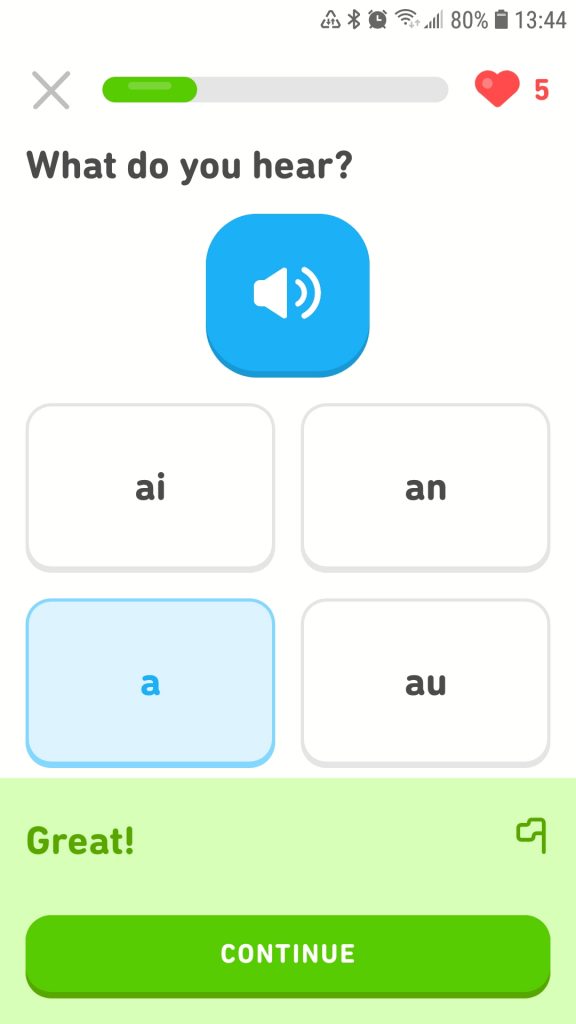
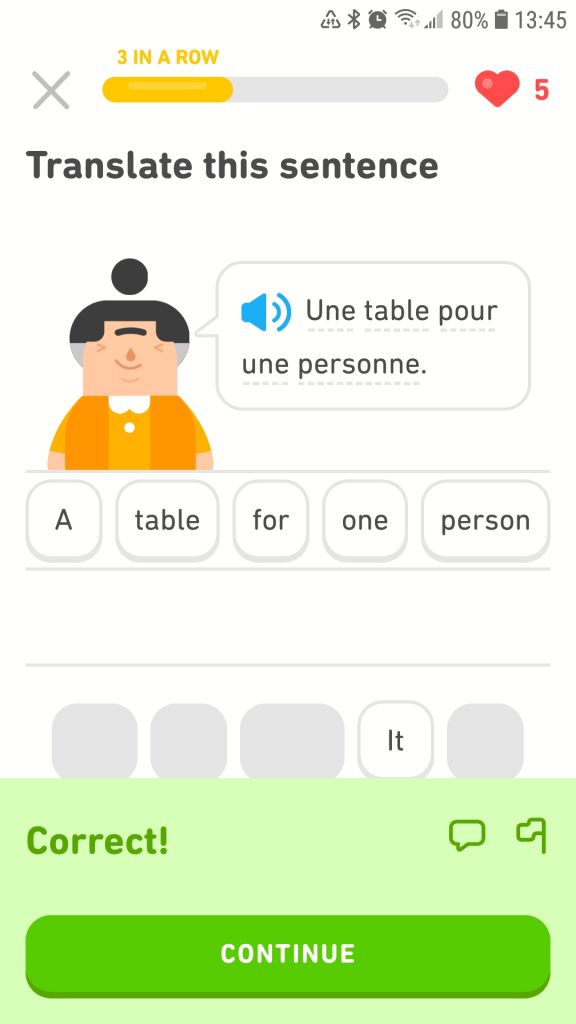
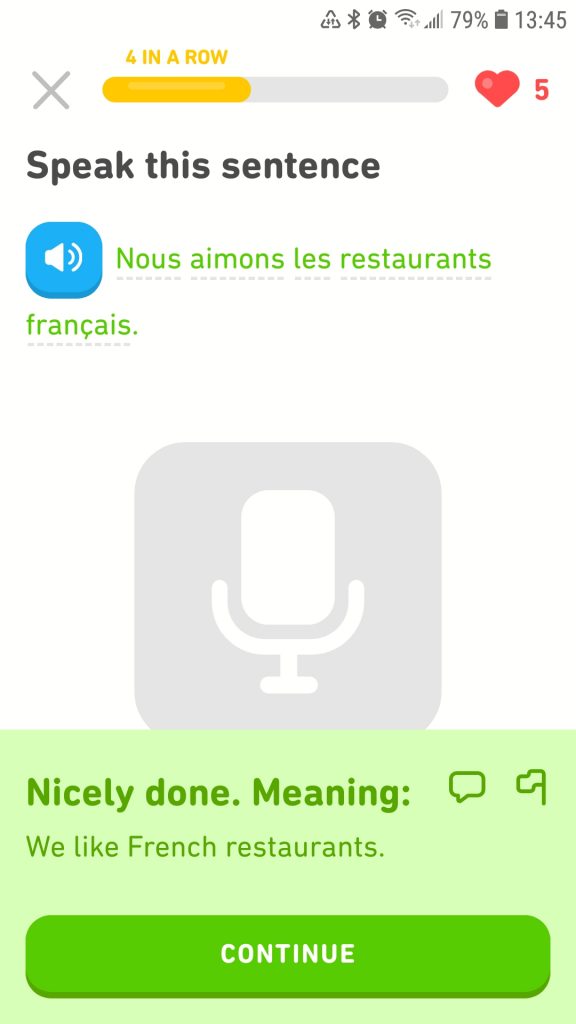
Later I had a more complex exercise set- not just translating and small repetition, but filling in blanks. Now I need to really understand.
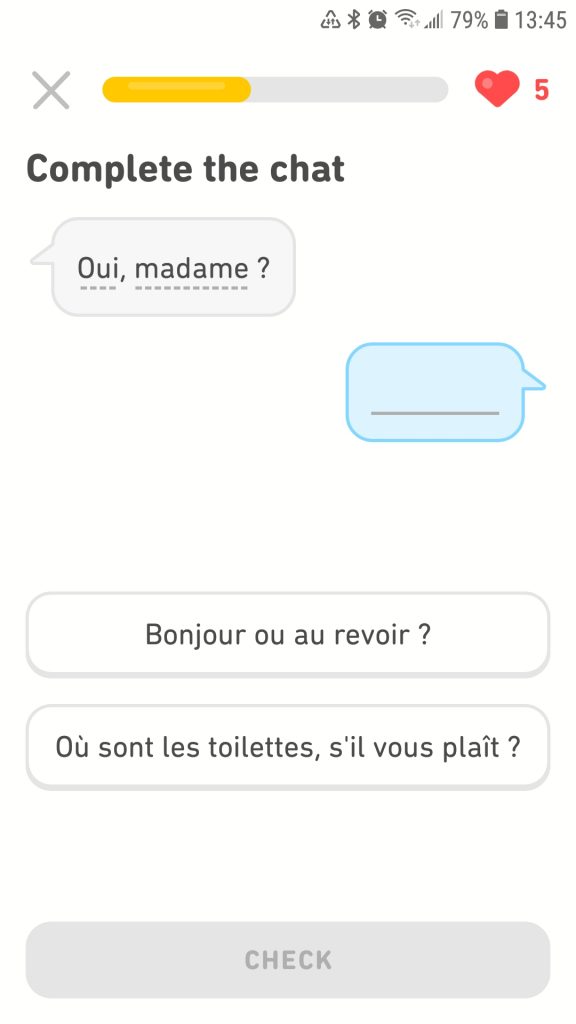

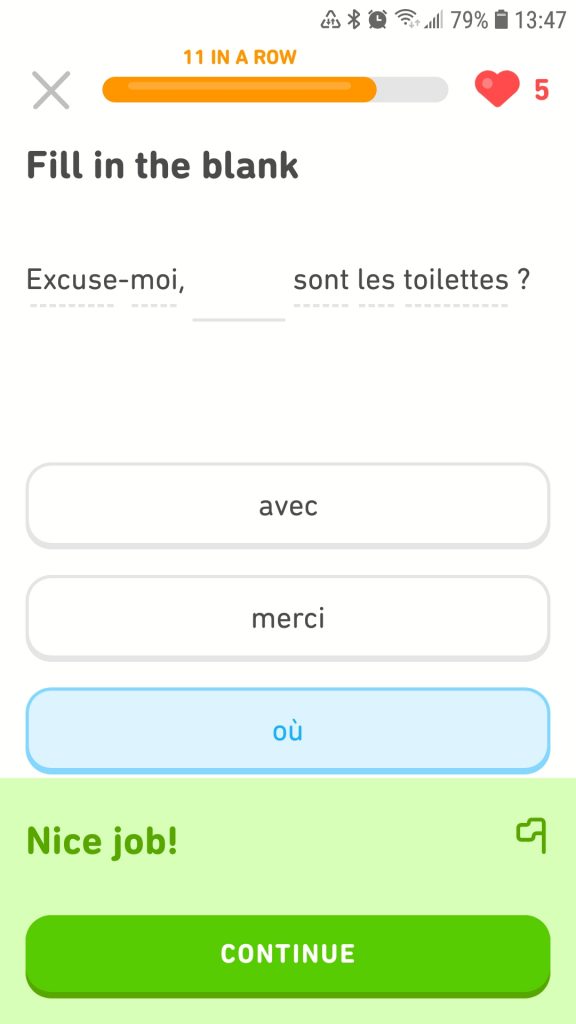
It started well, but later I ran into harder ones, one of which I’ll share here- an exercise it took me 3 tries to get right. Usually, Duolingo just keeps going and says “try again later” and I get to it at the end, but it kept repeating so I had no choice other than to do so right away. Maybe it knows when to push haha… anyway- it was a success in the end! Again- I fell on the spelling. It seems like my weakest point at the moment, so it may be what I need to focus on next. After focusing on sounds a lot lately, now it’s time to balance it up with some writing. Engaging different parts of the brain!
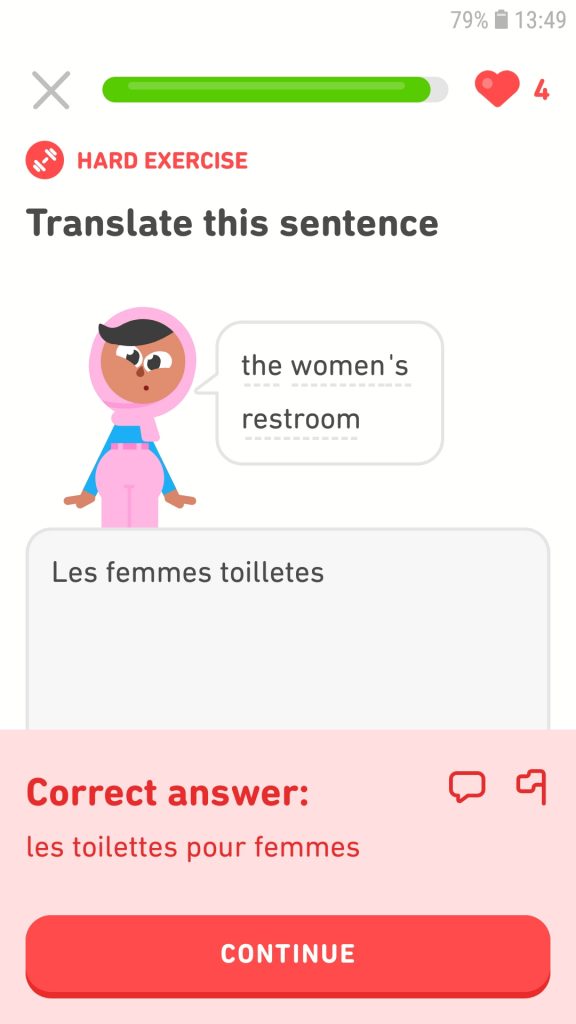
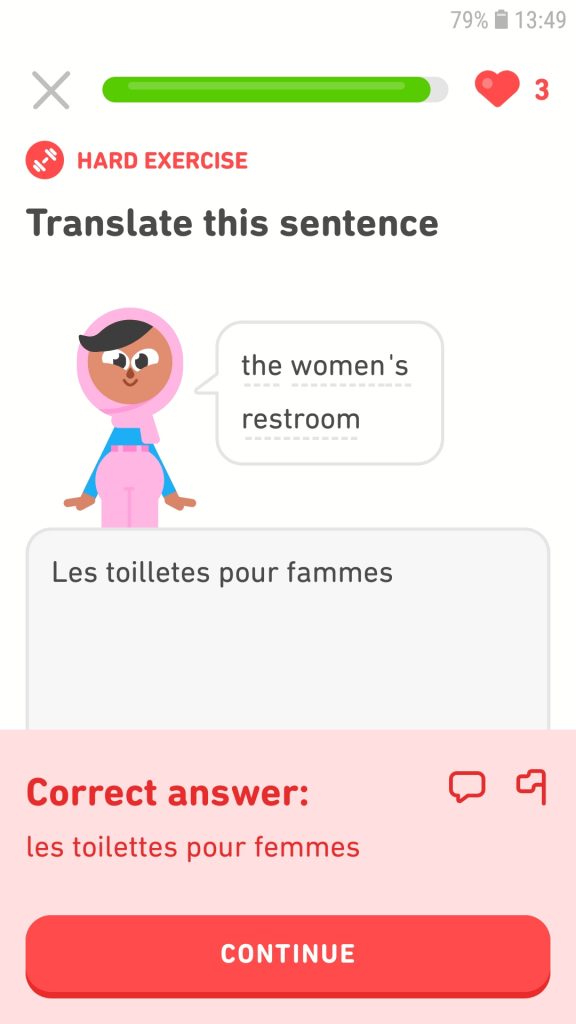
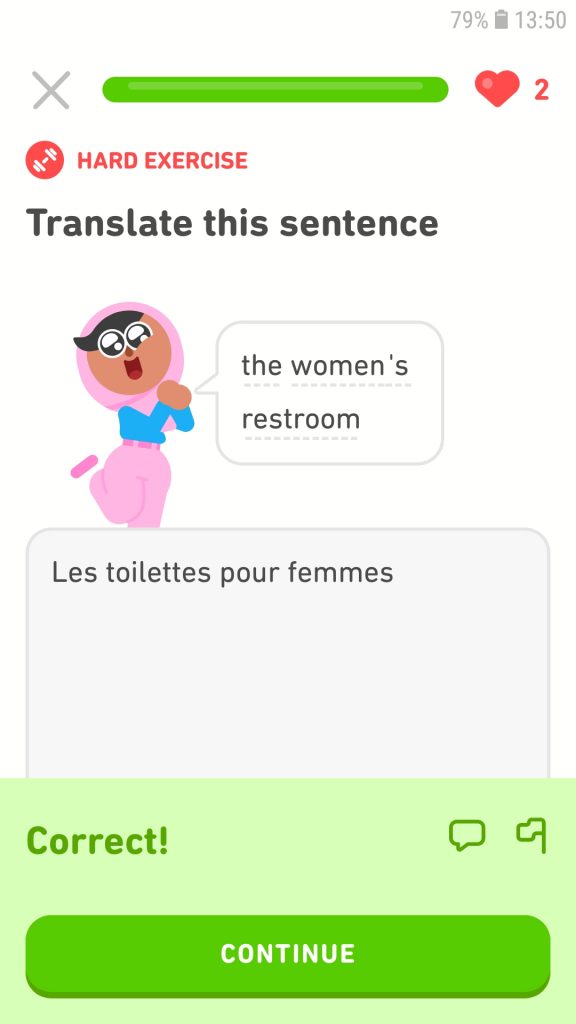
Later I found a new helpful series called learning with Alexa. This is a nice series- and even just hearing the language for a little while felt helpful. Her pronunciation is clear and she covers quite a few themes in many videos. One helpful thing here is that it turned out to wonderfully and accidentally combine with my Doulingo learning. I learned in Duolingo about cats, and in the video below cats are used to learn new words. Great luck! Also, the difference between “above” and “near” in French was helpful, it can all be so confusing as the sounds are similar, just like the “a” sounds we chatted about above. This one is about propositions. I found it helped with my latest Doulongo lessons, as it felt I can use it all together. I like how she said “I know what you think, it’s a long sentence I can’t do that- but you are!” haha that was exactly how I felt. I appreciate the context with which she is teaching- it makes a difference and helps my learning sit on a more concrete ground. I also learned “baisers” – kisses! As she said it at the end I looked it up, I knew “aurevoir” from Doulongo and this is different. More resources = more learning!
This is it for today, I’ll be working on preparing for my final project of learning French, and keep on repeating what I already know to instill it even more. I’ll send you one of my favorite songs, that has been on repeat lately. Now I can get the words! But the music was what caught me first. Plus it’s one of these timeless songs- always golden! Enjoy!
How do you find music helps you learn new things? is it in the background / with words/ just instruments?
What are your favorite French songs? I’ll be happy to expend my list. Feel free to share with me in the comments!

Chat soon!
Maya
Digital citizenship is “the continuously developing norms of appropriate, responsible, and empowered technology use” (taken from Digitalcitizenship.net). It’s an approach and skill set that can empower and open options in an ever-changing world. The way I see it, other than teaching certain skills, we need to teach also how they connect to other cultural, social, and other topics, and especially to learn how to learn new skills. Ed-tech can make this connectivity open even more doors.
Digital citizenship and the curriculum
Digital citizenship can be embedded in so many parts of the SK Curriculum. I’m a strong advocate for cross-curricular lessons. When we teach things connectedly, with other topics, skills, and the students’ interests, we can have a more natural understanding of what we learn.

For example, the SK curriculum identifies at Career education, grade 6, under cross-curricular education and “developing thinking” themes, that “Learners construct knowledge to make sense of the world around them” (Taken from this link in the SK curriculum).
Integrating digital citizenship in my future classroom
Integrating digital citizenship in my future classroom will require us to be curious cats. It means to learn the above and more, adjust, and be flexible and curious to make it work in an ever-changing environment.

We can have guidelines to help us through, which is a huge help, but we also need to keep an eye on the class’s needs and how we can make it work best in our own environment. To do so, I think it will be helpful to focus on 2 things mainly.
The guidelines can be the 9 elements of digital citizenship:
Ribble’s nine elements of digital citizenship
Ribble’s nine elements of digital citizenship can provide us with guidelines for how to embed digital citizenship in our classroom and more. One of the elements discusses digital access. This one is an issue I have had to work around, as I taught over zoom in northern communities close to home that has limited wifi access. I was a guest in the class that day, and the grade level was pretty young. I was mostly in touch with the teacher who collected the students’ zoom info and made an “online classroom”. The biggest thing was troubleshooting during class and being flexible with students. It was helpful to have more adults in the class, so one can admit students in, be in touch with parents who tried to log in and had issues, and so on, and one was teaching the subject. It was also helpful to have the class’ teacher with us, as her relationship with the students helped overcome the online gap we were missing in communication. This included knowing which students need more help and approach them often (they may be muted and not know- so the teacher knew to keep an eye on them). There is so much to navigate through, but I think with flexibility and collaboration, it can be done and even open new doors. One new door was reaching communities I could not have made it to otherwise, because of the distance and winter driving conditions.

Digital citizenship has many elements that can be embedded in the curriculum, from commerce, law, health, collaboration, and more. If we see the connection of it to core competencies and content, it can be a way to teach in a relevant and interesting way. Like planing a new seed every time, and seeing how the plants connect in one big network of gardens.
What do you think of digital citizenship? Let me now if the comments!
Yours,
Maya
Hello, and thanks for coming back to my blog! this week I’d like to start with why I chose French to begin with. Branden asked me this question, and I found I wanted to share it as I haven’t really focused on it yet. The first answer is I wanted to open more possibilities. Not just travel when we can, but also in travel now- when going to a local French restaurant, speaking to friends that are French, and more. I feel like the more languages I know the more options I have. And I love this sense of freedom!
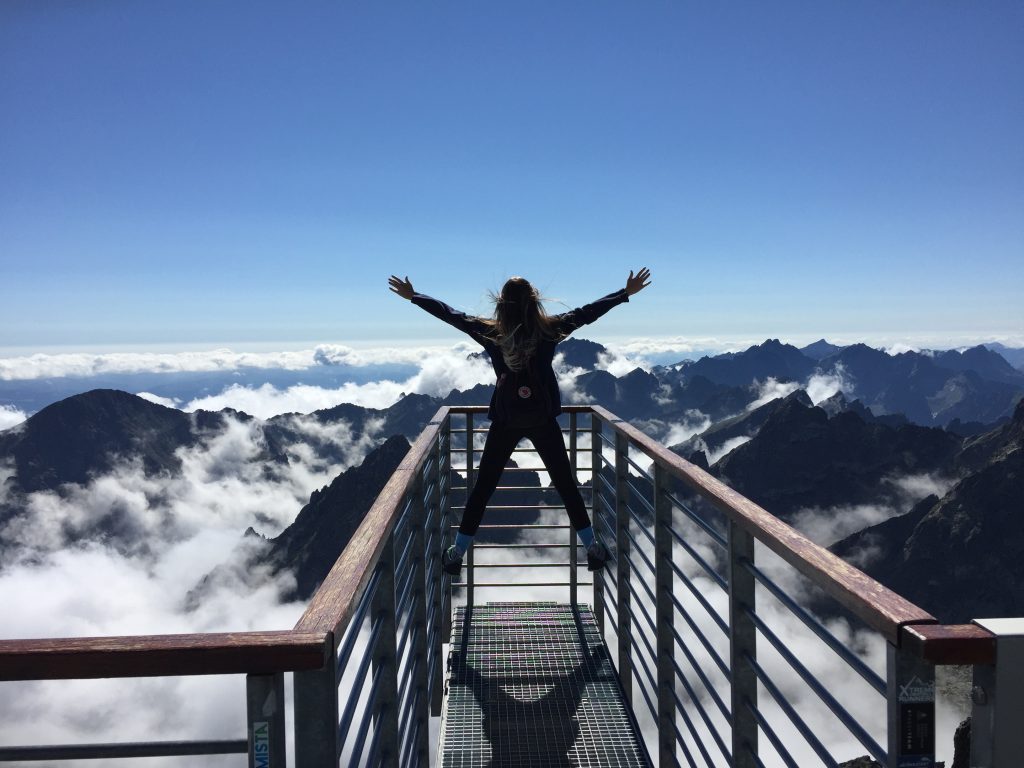
When I traveled to Switzerland a few years ago, I remember not knowing almost any French, and diving into the place. Ever since I got back I wanted to learn more French, and am glad this course has brought this goal back into my life. The first thing I learned is how to be curious and explore as I go, outside the books.

One time when I was in Swiss, it was rainy, I was at a local store, and needed to get an umbrella. I had no idea how to say “umbrella” in French, so I said “the thing for the rain” (which for me was a lot to know! a full sentence!) and oddly enough- it IS how you say umbrella! “parapluie” = umbrella, and meaning literally – “For the rain”. Para- for, and Pluie- rain. So I learned it’s ok to be confused, try, and try again. This happened again this week, as I remembered I keep mixing up “travail”- meaning “to work” and travel in English, which is the opposite… only this time I have many more tools to keep learning. So this week was about mixing up a little less. I had a hard time adding new things as I kept mixing up what I already know.
The plan was amended, and I’m now continuing to practice conjugating “travail”, “Vouloir” (to want) and added just a few new verbs in school and travel themes, like “Lire” (to read), visite (visiting), and country (pays). I’m starting instead of adding only new verbs, to also focus on partially practicing what I already know and partially adding new words that will fit in a school setting. One more recourse that was helpful and recommended by Haley called Word Reference and works better than google translate, in case I need a quick reference.
Focusing on the foundations is more than a one time job
Focusing on the foundation is an ongoing job. I love to see progress, but learning new languages forces me to focus on, how my friend Michelle says “work smarter not harder”. This means, in this case, to keep feeding my foundation practice as I add new things, rather than my usual crossing items off and moving on. The way I see it, it’s adding more plants into my garden as I go, while watering them all, rather than moving on to the next step and forgetting the previous one.
I found there are many ways to explore and be curious. Like taking my learning outside, reading, and finding what works for me that day. The more options I have, the more freedom I feel. All the tools I’ve collected so far will help me adjust the learning process and make it work in the busy school- work- life cycle I’m (hardly) balancing!

So on to my weekly practice. This is a glimpse into my Doulingo slides and chaos.
First, I reviewed the previous verbs, with the intention to make the basics stronger. Then I added this week’s new themes and learned the basics of school and travel themes. Here are some of the slides that I reviewed:
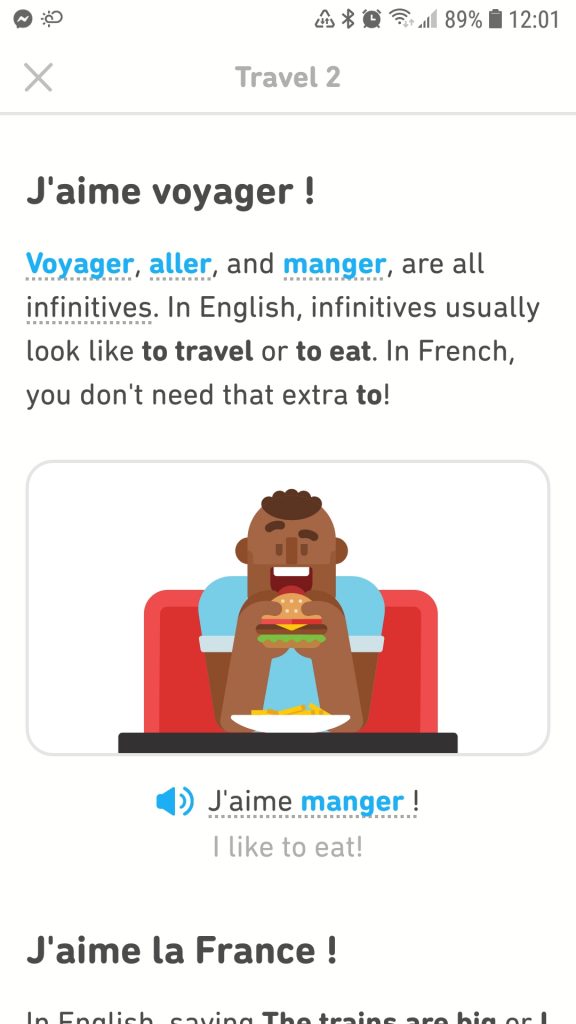
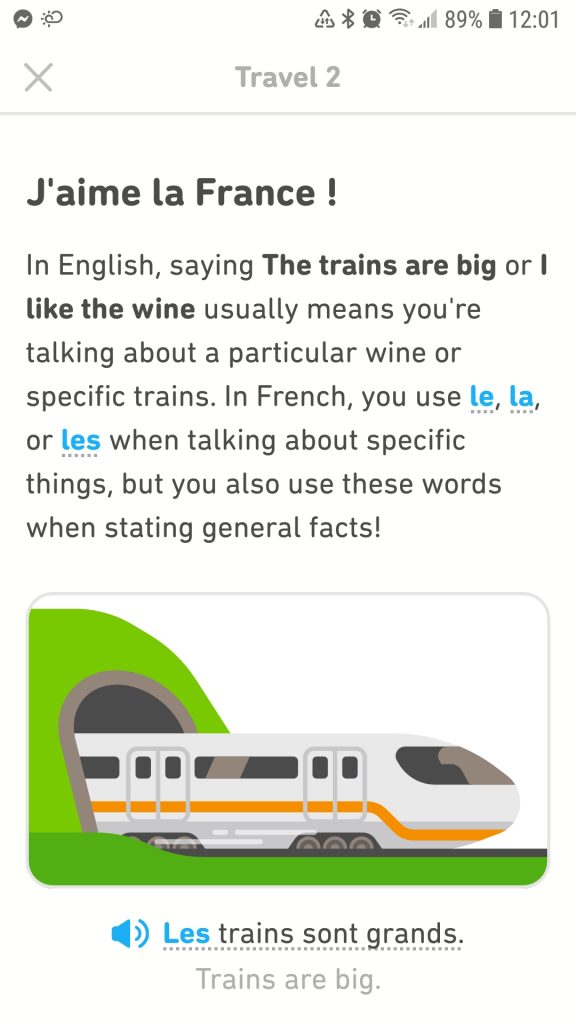
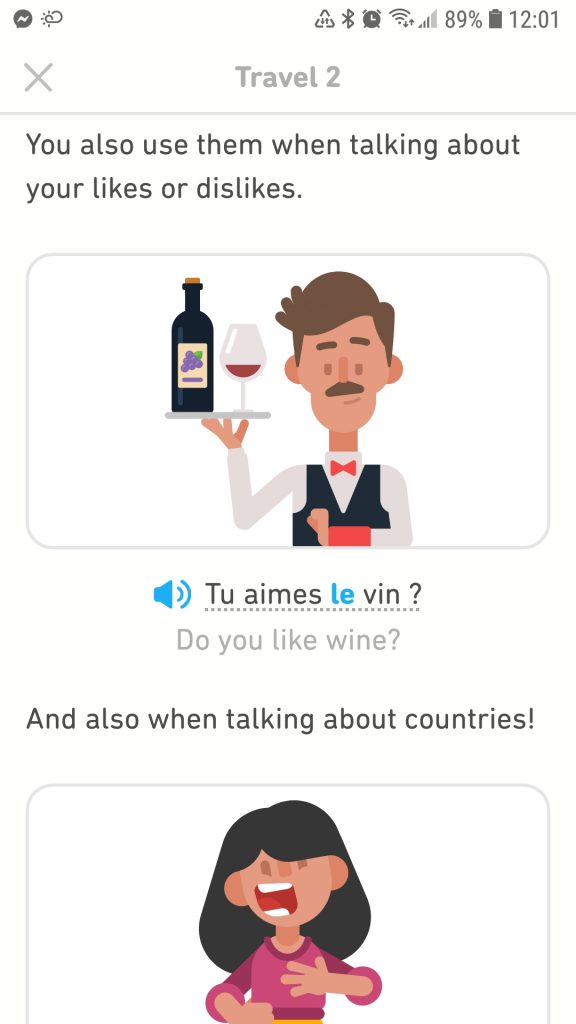
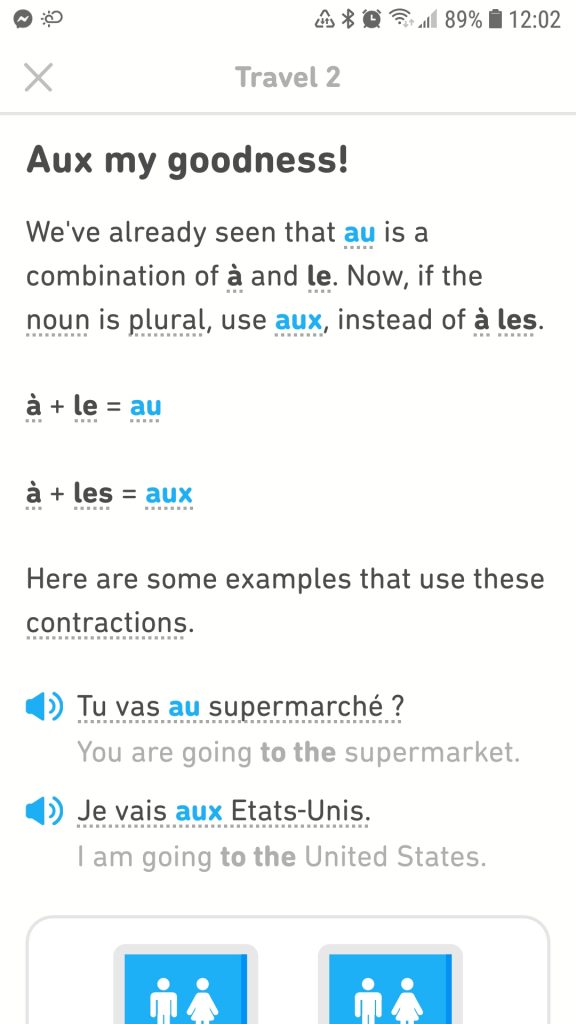
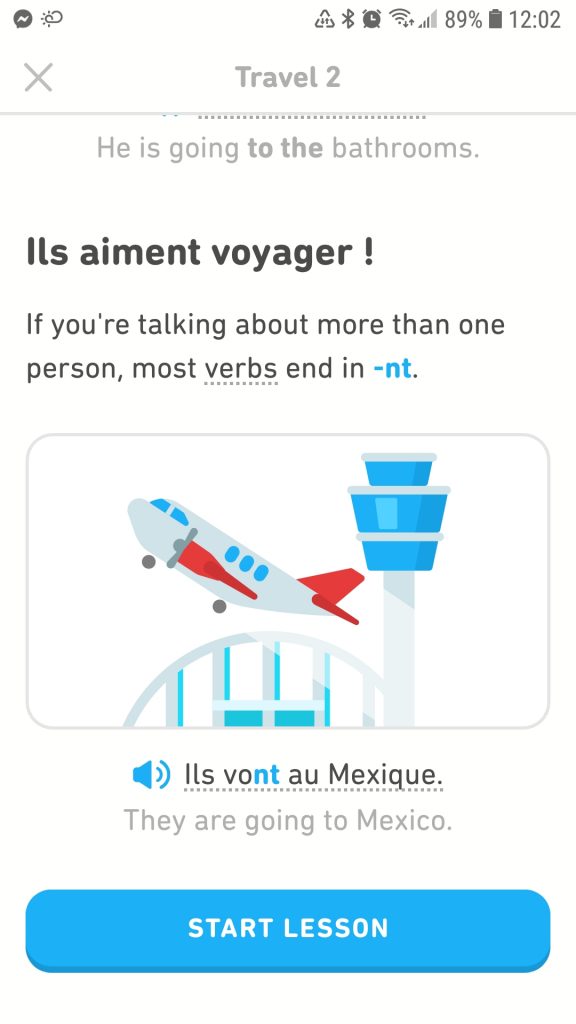
I then had my class, and as always, used the hear, speak, write (and this time in the context of the conversation- super helpful!) and read. Here are the first 3 slides from this class:
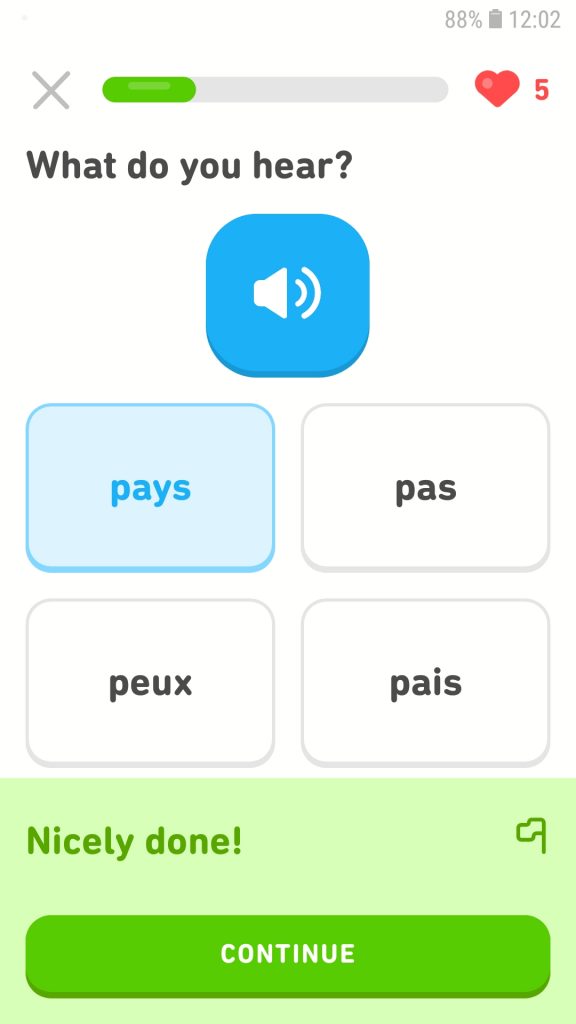

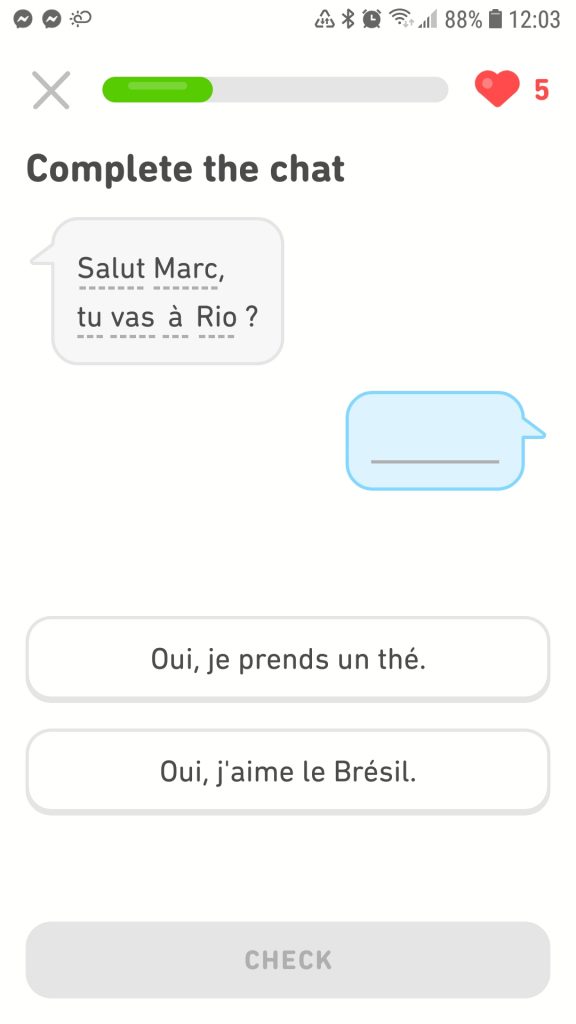
All the small differences with Aux, le, la… I can’t emphasize enough how much repetition helps. It’s so confusing, and the more I repeat, it doesn’t get boring- it gets more clear. More new words this week are, as mentioned before, pays (country) and visite (visiting! – yey an easy one!)
To Finish, I’d like to share with you a video I love to watch every now and then, showing the importance of language in our world, identity, learning, and more. Learning a new language is learning a new way to communicate, think, and expand in ways I did not know before.
What do you think are the benefits of learning a new language? Remembering this through the hard times of learning can sure help- I know I needed a reminder this week! what helped you learn a new topic/language? Would love to hear your thoughts!
Chat soon,
Maya